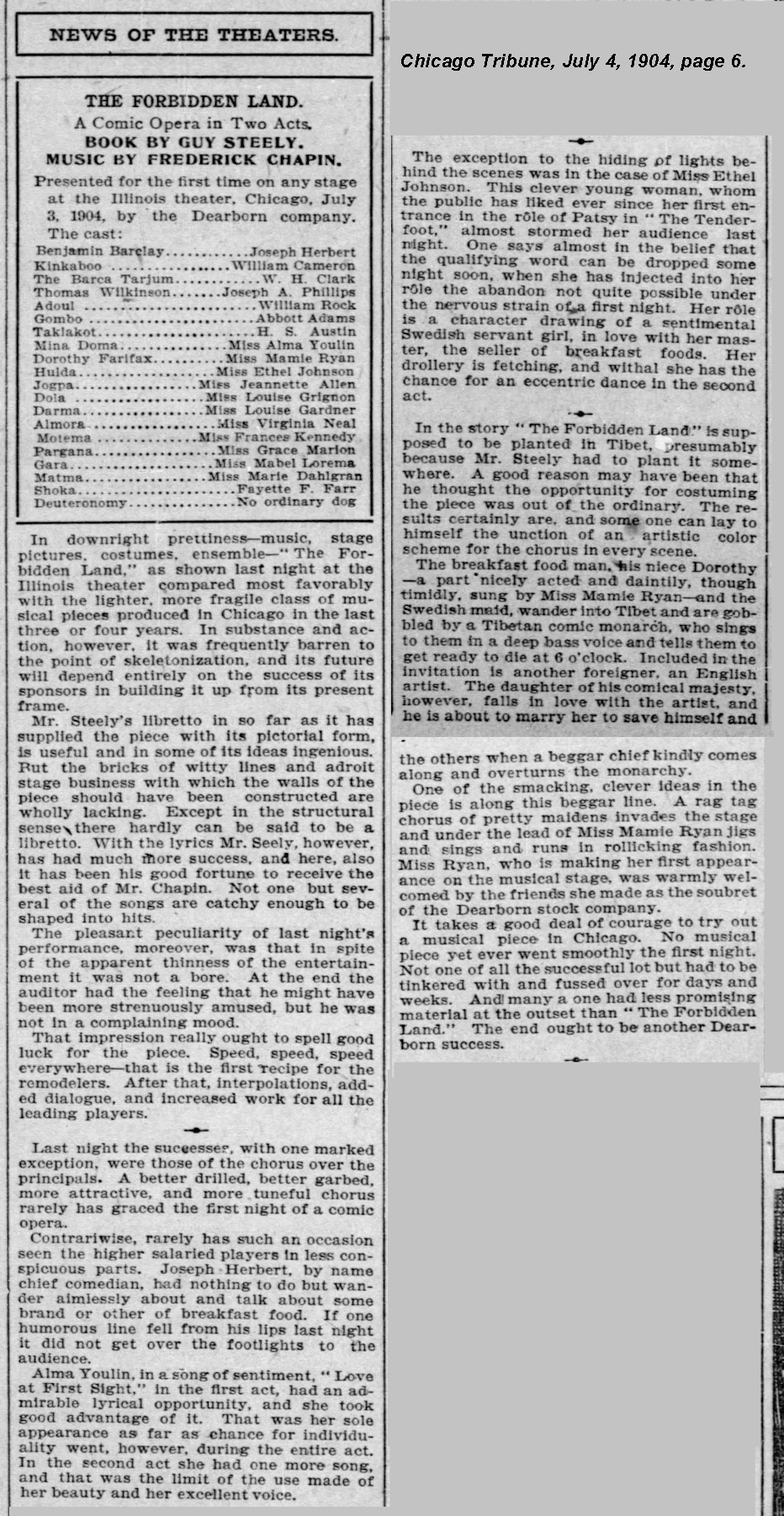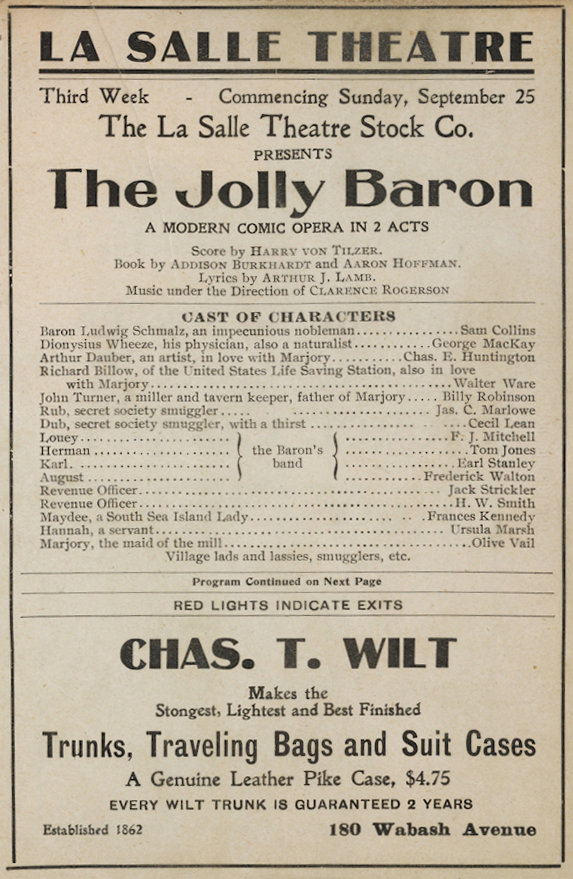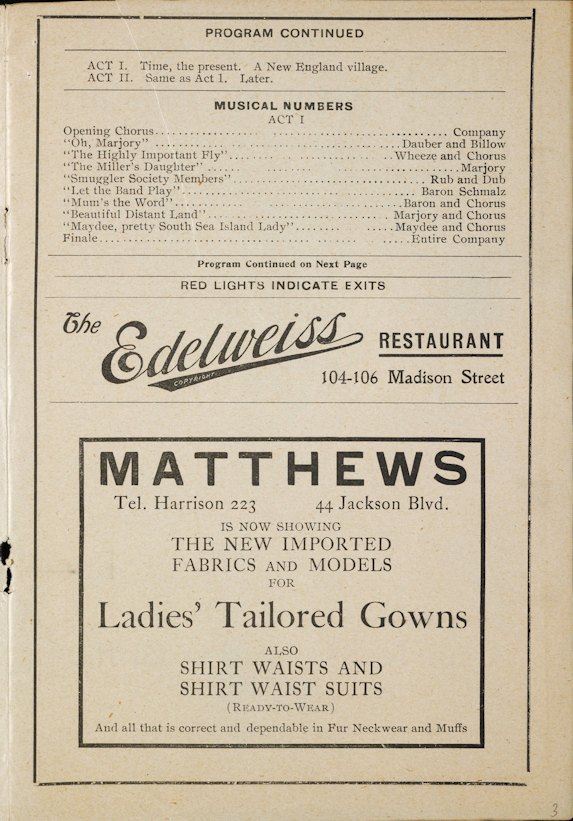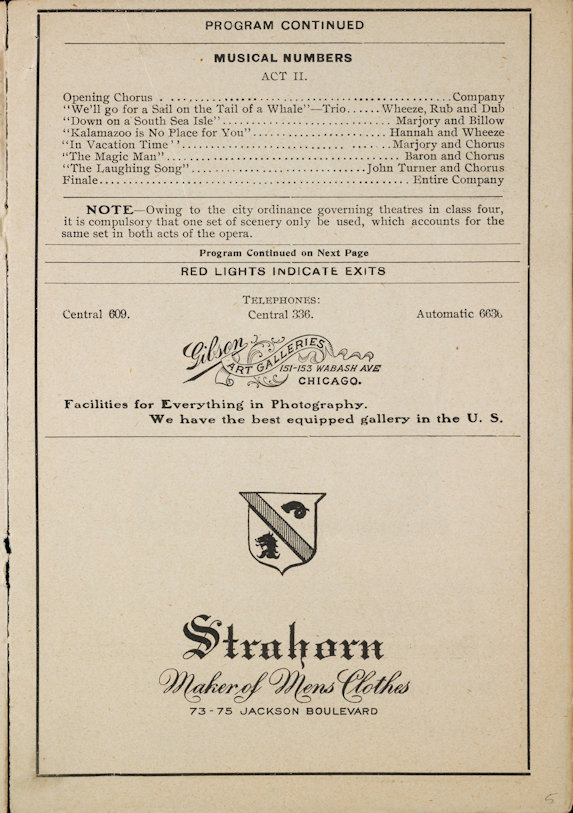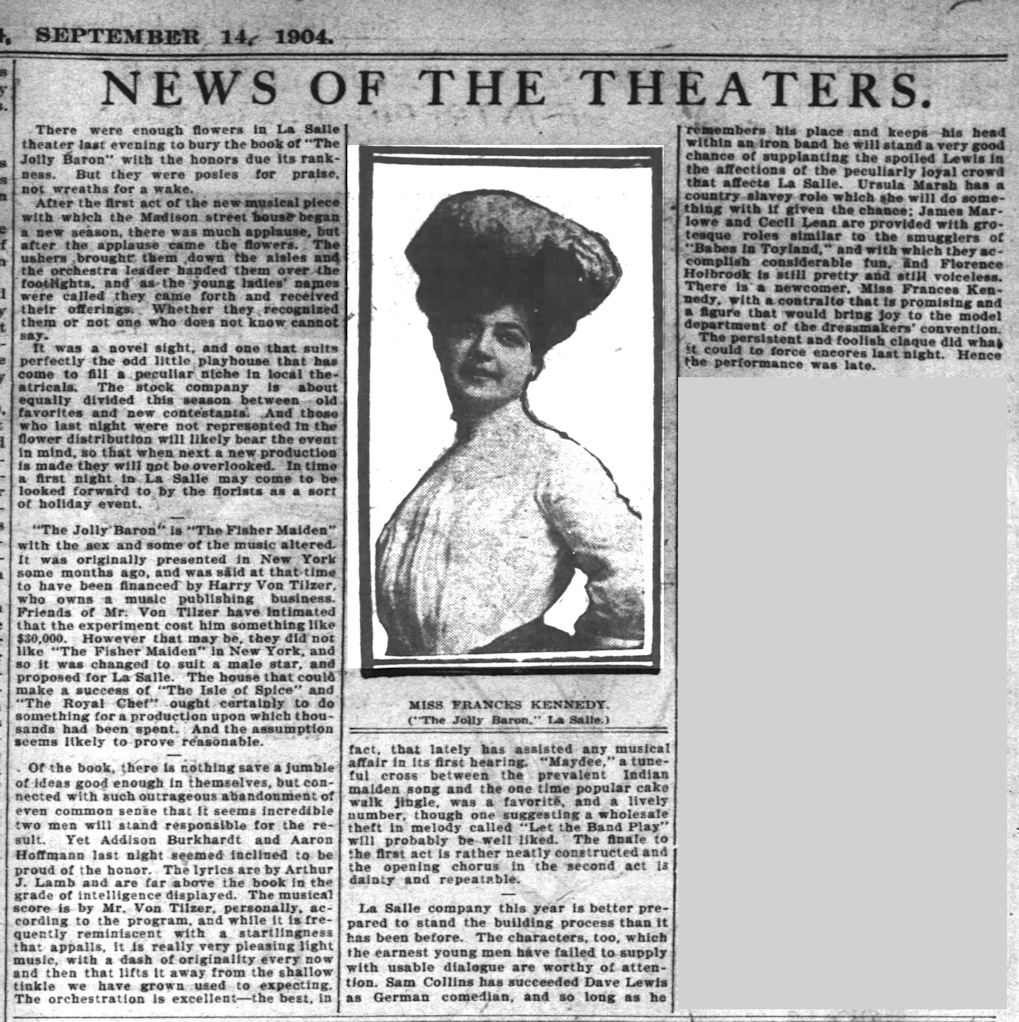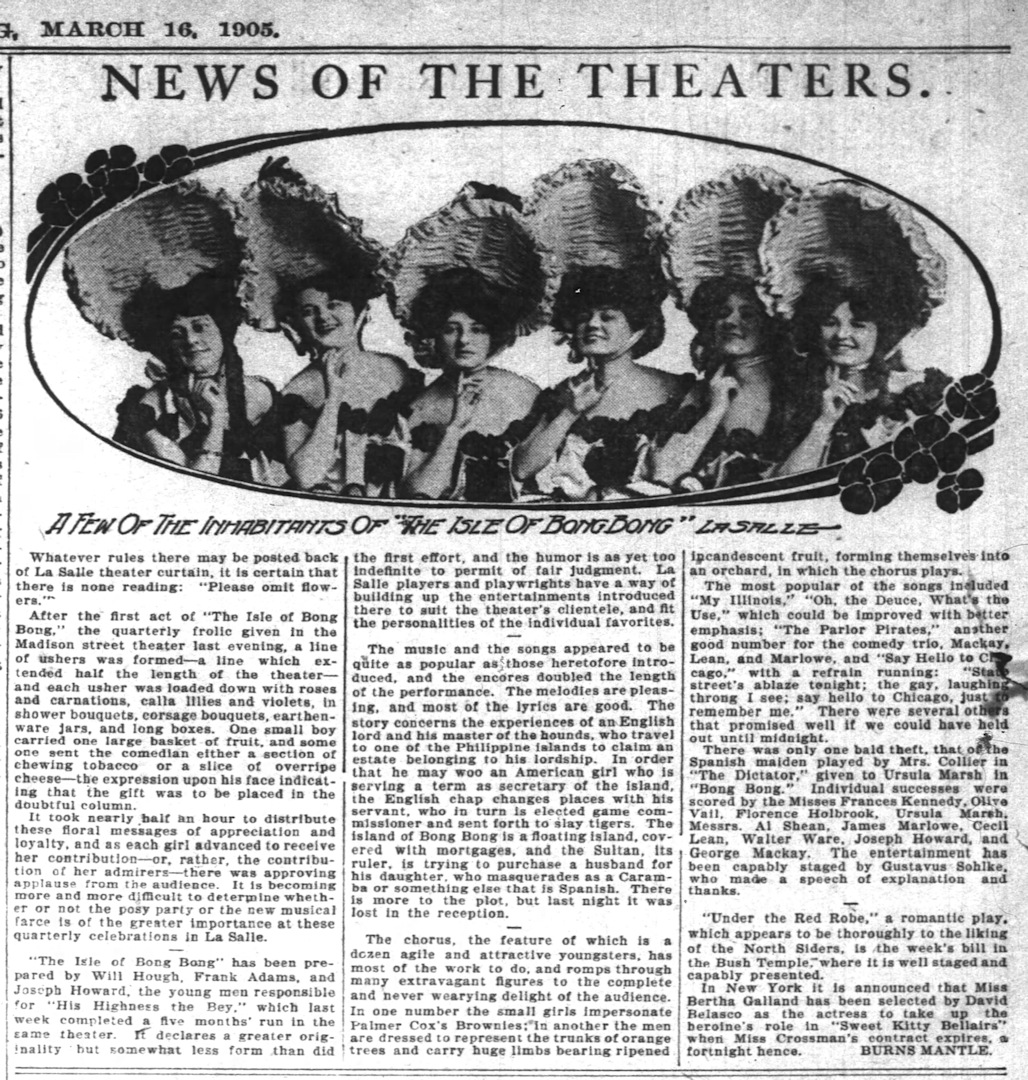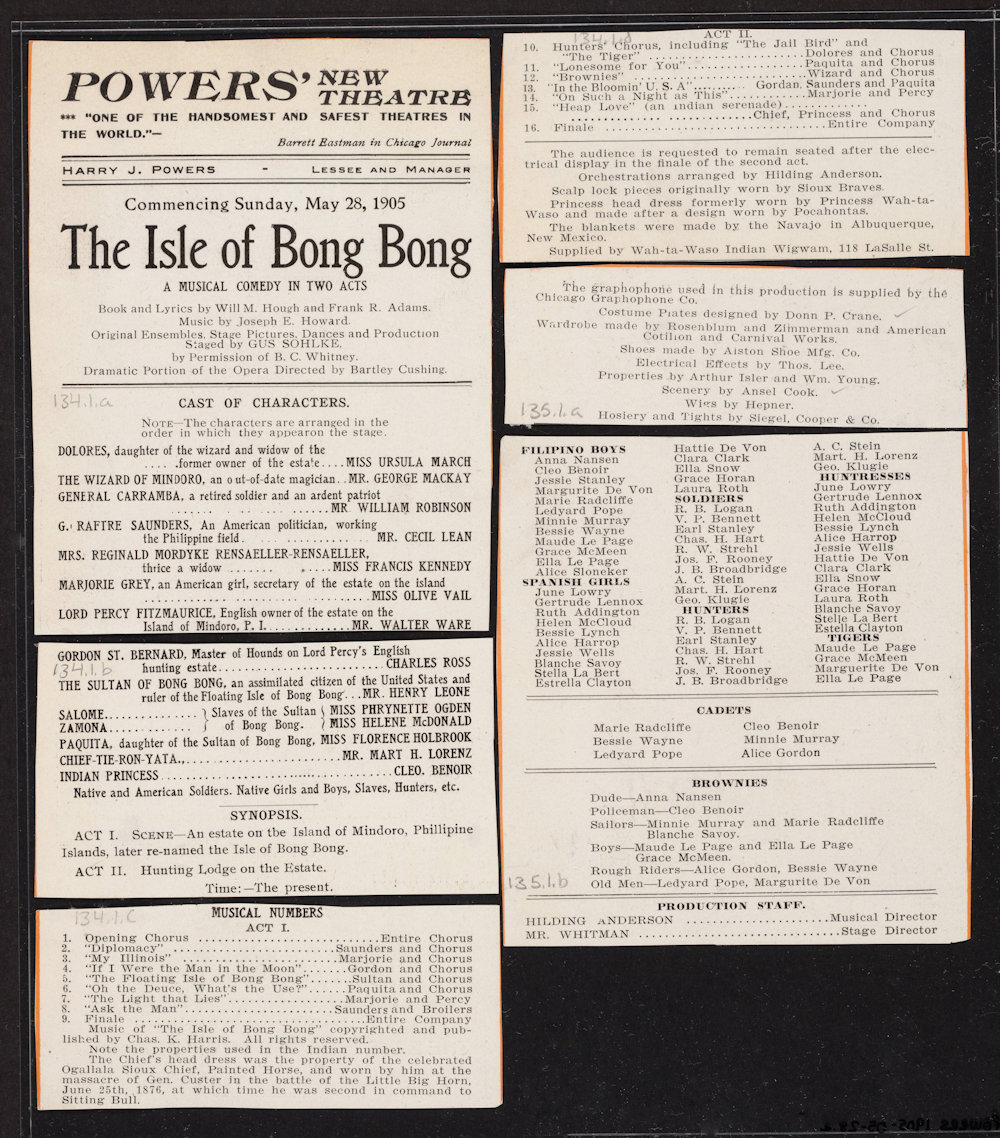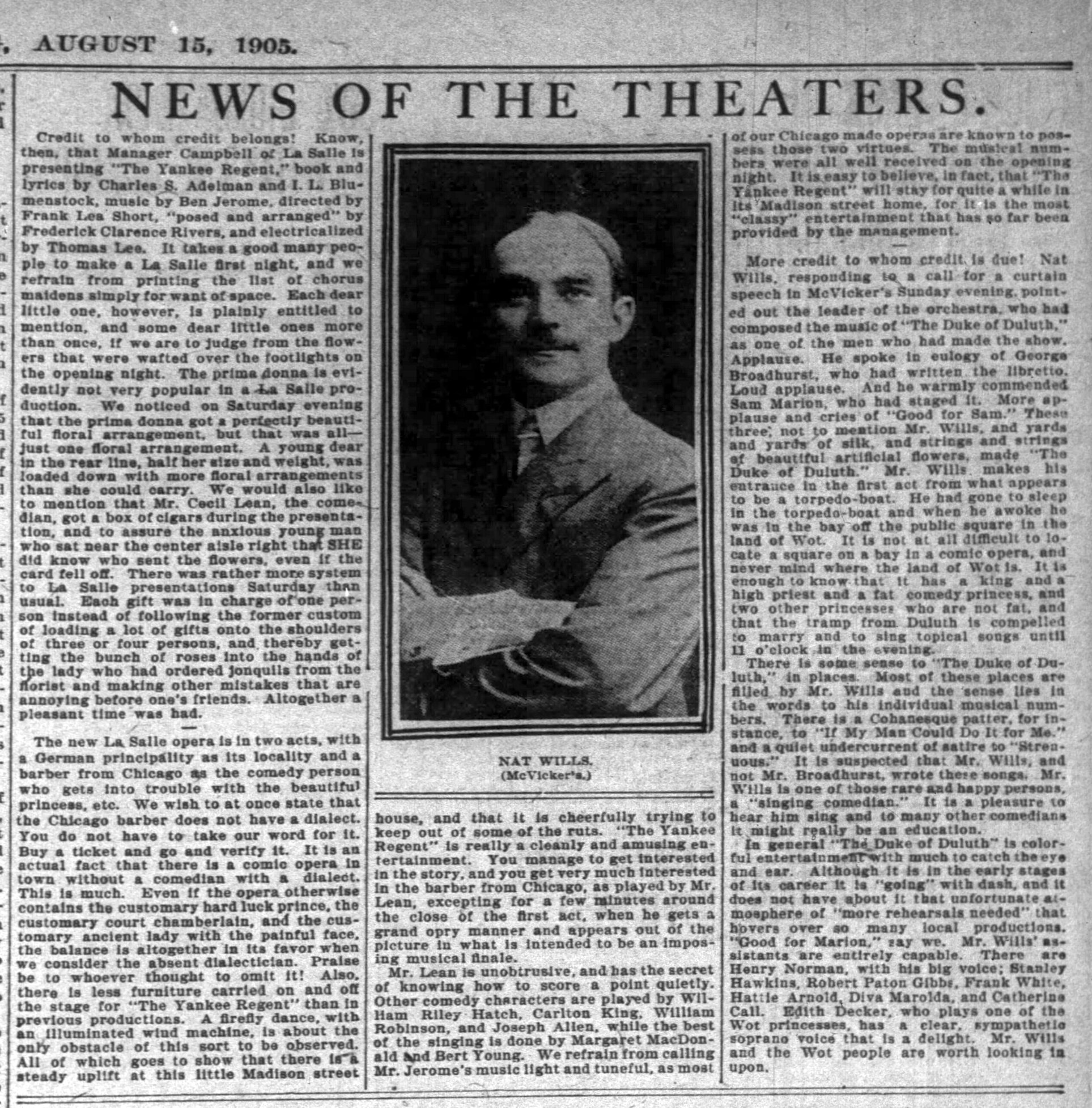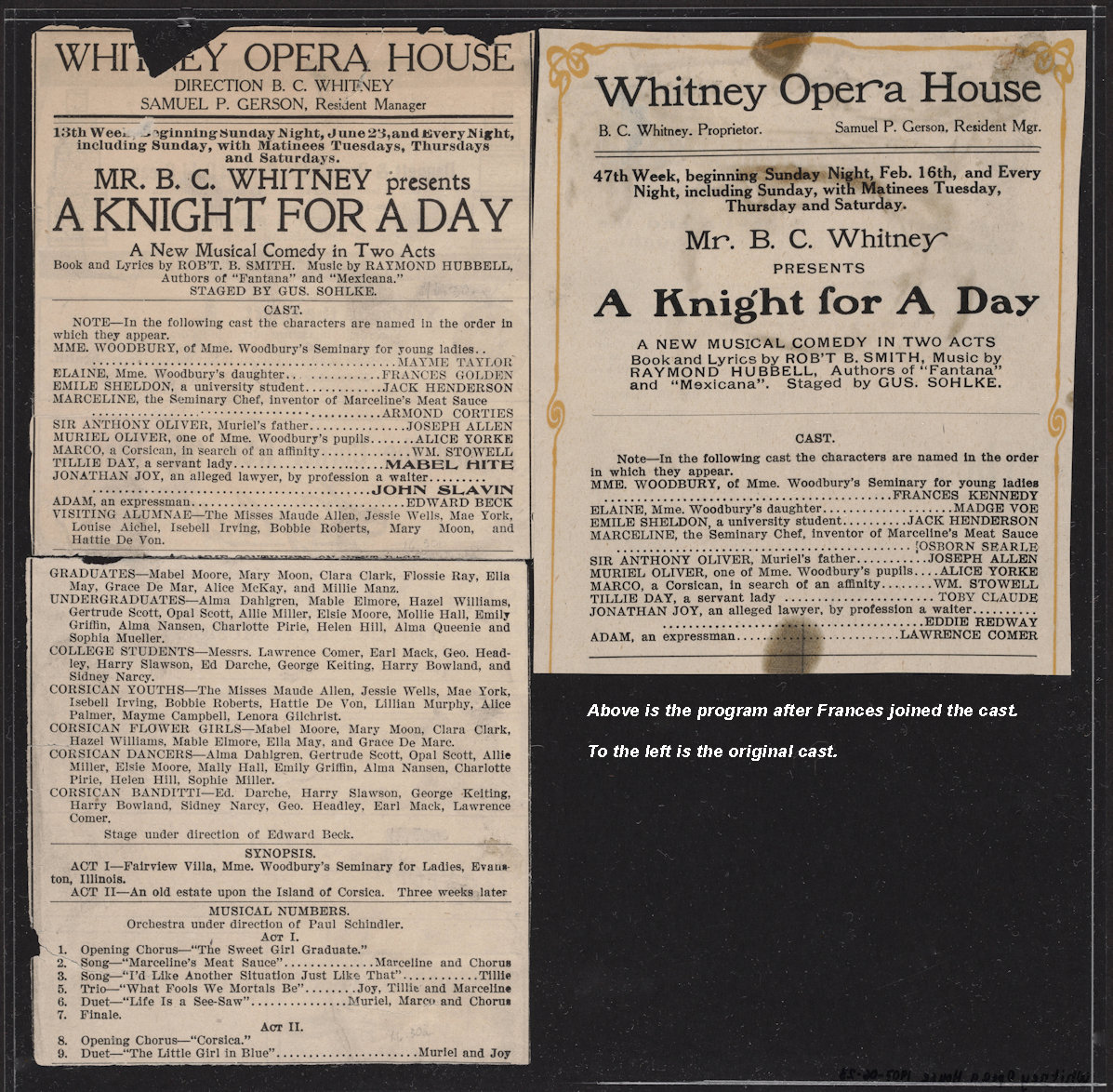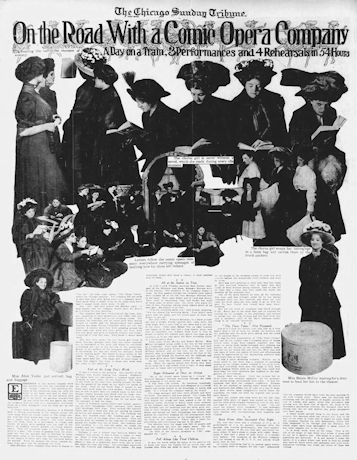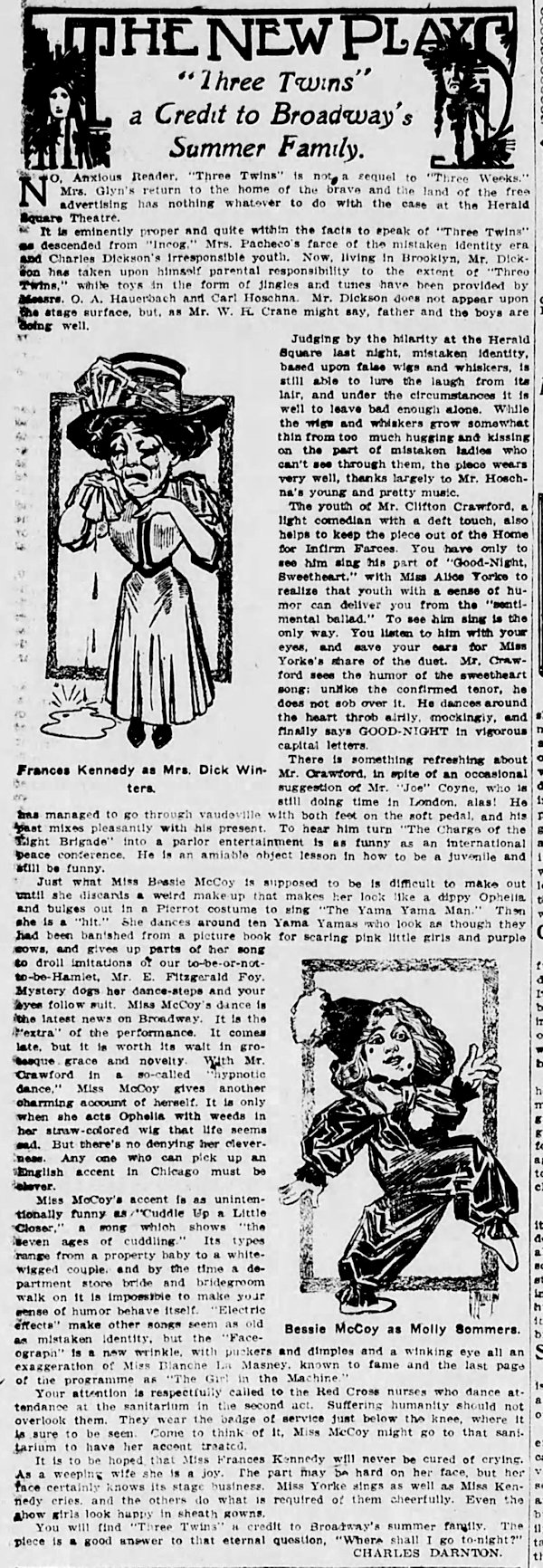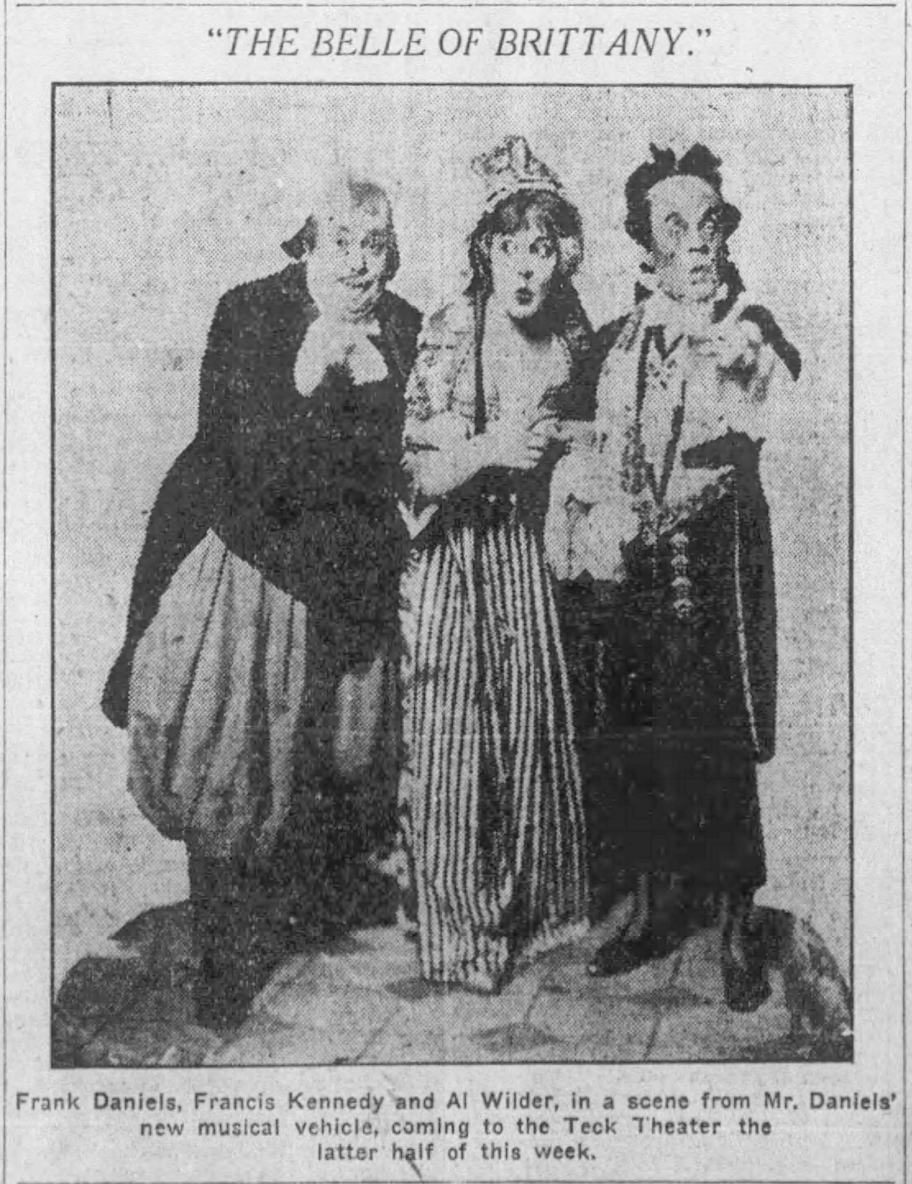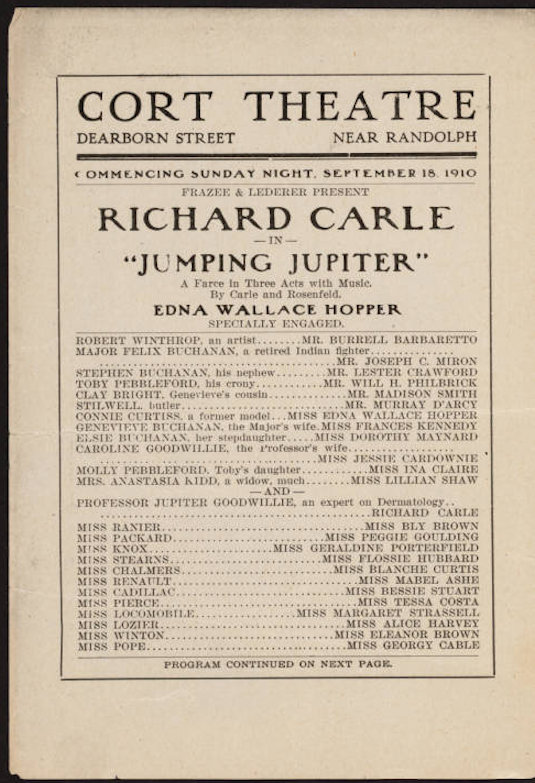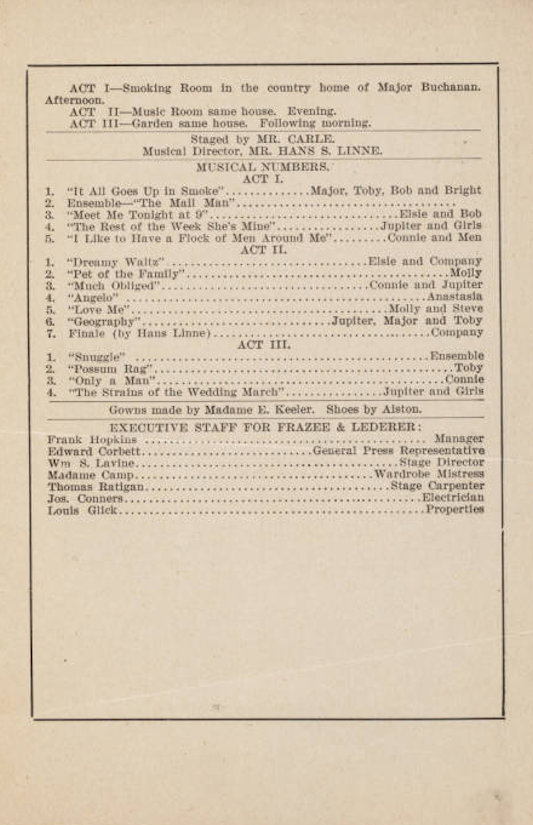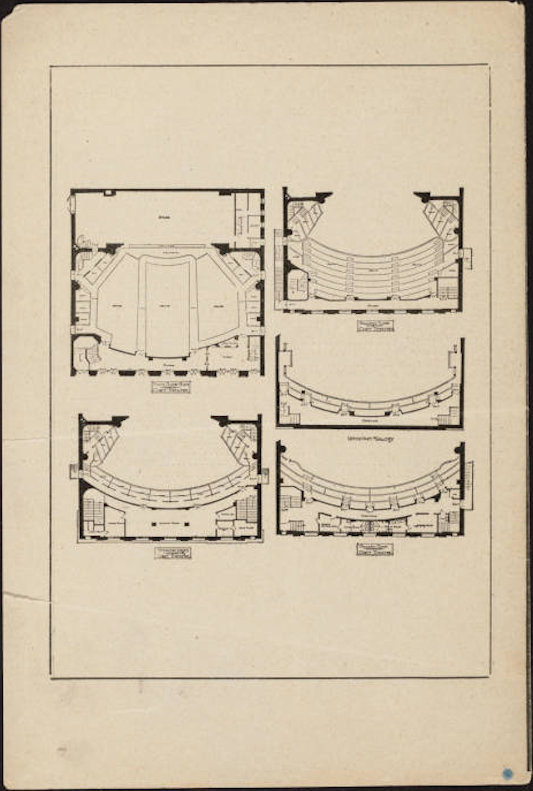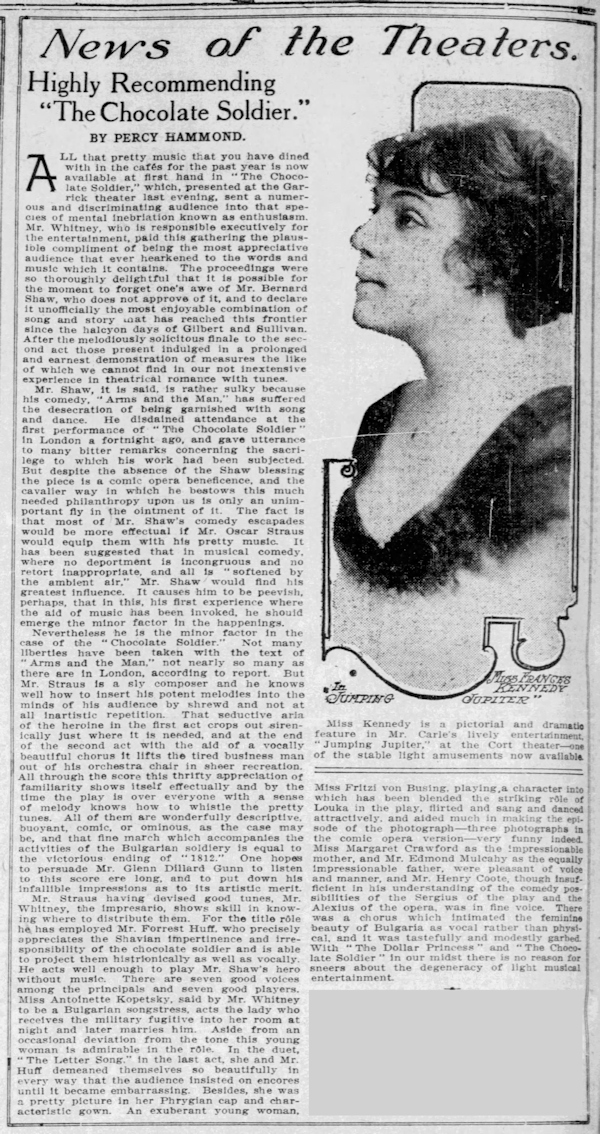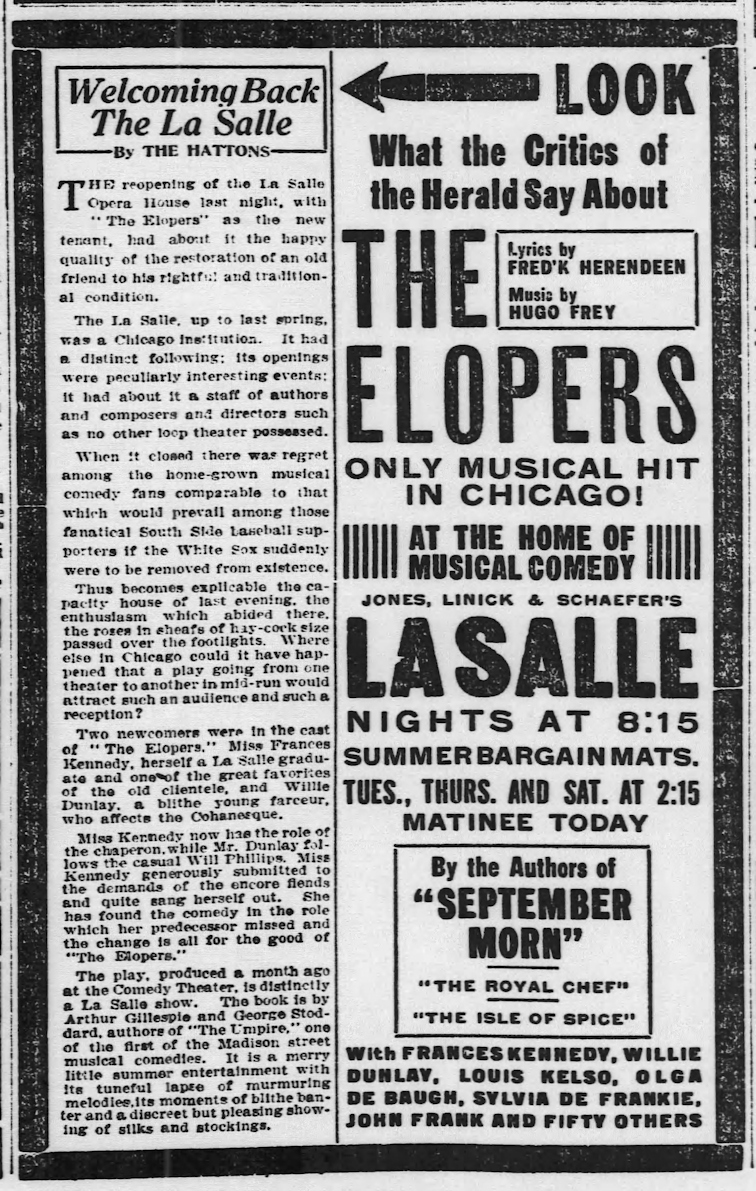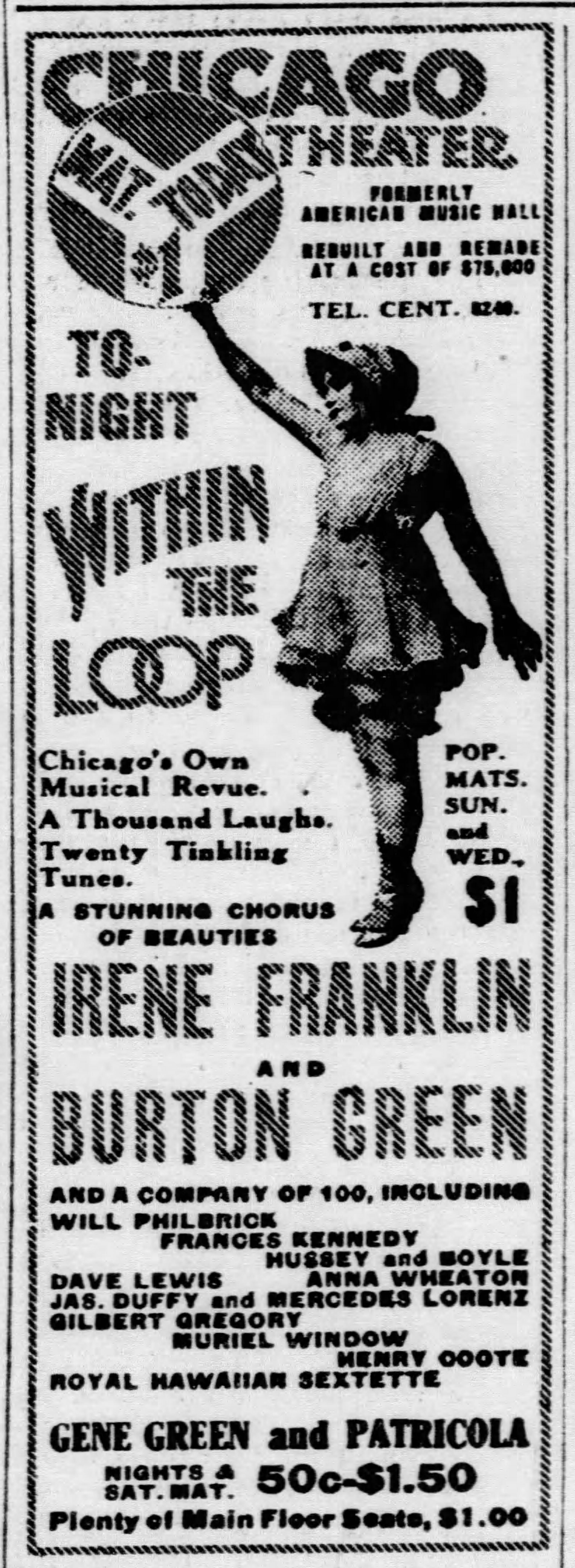"Sing, Sing, You Tetrazzini, Sing"
-The Musical Comedy Performances of Frances Kennedy
I fell down a rabbit hole. While doing the web page on Frances Kennedy’s career on stage I got curious about the musical comedies she had a role in, whether as a principal or in the chorus. This became a “slice” of musical comedies through a specific period, and generally a specific place: Chicago. Some of the shows born in Chicago went to New York. Almost all went on tour around the Midwest bringing in audiences hungry for music and comedy an age before radio and movies.
I’ve gathered the information about the musicals from contemporary newspaper advertisements and reviews, sheet music covers, and in a few cases recordings of the songs in the shows. My favorite is “Sing, Sing, You Tetrazzini, Sing” with which Frances introduced the music in The Red Petticoat playing “Sage Brush” Kate.
These musical comedies were farces by in large, part of a boisterous era of Chicago theatre.(Footnote: Throughout this page I've used the spelling "theatre" which was used indiscriminately during the period covered - as it is today. Some say "theater" is the accepted American spelling as opposed to the British "theatre." A lot of hooey that is as far as I'm concerned. ) They were the sitcoms of the day, but with lots of music and lots of cast. They may be of interest to theatre historians, but whatever the case, this page gives a glimpse into the shows that one actress and singer, however obscure she may be now, was involved in. There were many like her, some who may have done only a few shows, others who went on to vaudeville and their own personal or public fame.

The posters and sheet music covers “fly-out.” Newspaper reviews open for zooming and in a gallery. Also, it loads
an embedded program from archive.org which is often busy. That usually loads, but may have issues.
This page is best on a desktop or tablet.
Mam'Selle Napoleon - 1903-1904
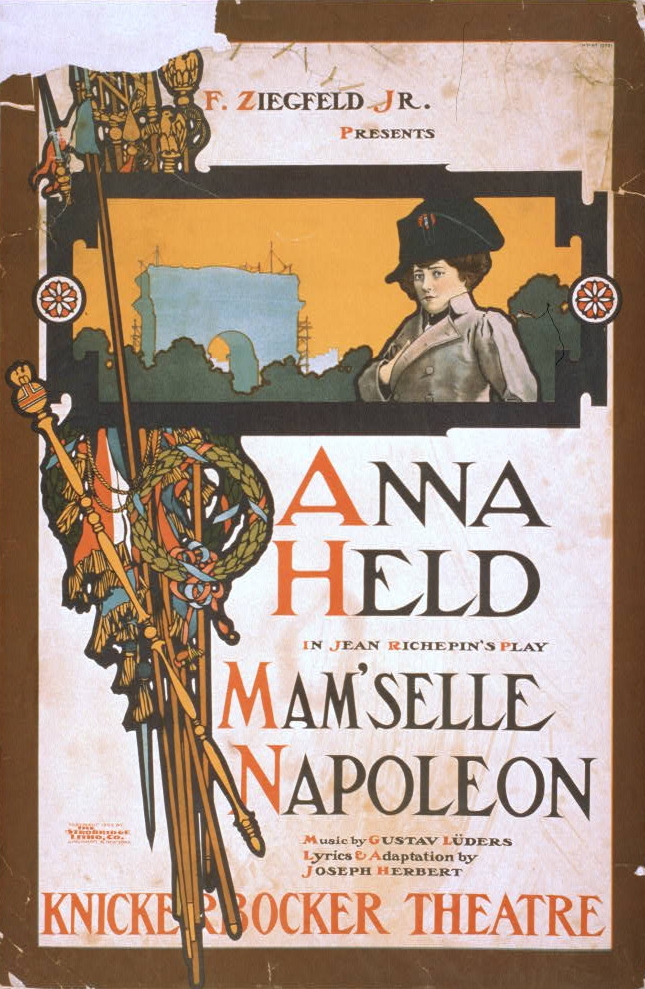
Poster for its opening in New York.
Generally accepted as a big flop although some reviewers liked it. Weak plot evidently but a lavish production of 5 scenes, some 44 speaking roles and a chorus of around a 100 people. A comedy set in 1809 revolves around Napoleon’s favorite actress, Mile. Mars. First scene is set in the dressing room of the Comedie Francaise, then on to Compeigne, Napoleon’s summer residence, the stage representing an island in the middle of the lake in moonlight. The third act is set in the Grand opera House, Paris, and then there is a “Return from Elba” in the final tableau.
The show opened in Philadelphia on October 28, 1903 and ended in Chicago May 7, 1904 after seven months on tour. It was on Broadway for 43 performances before setting out on a western tour that took it as far as Los Angles. They loved it in Missoula. It was an expensive proposition for Ziegfeld and was generally not well received by the reviewers.
There are midi files of some 22 of the numbers with an outline of the acts at The Gilbert and Sullivan Archive of the American Musical Theatre website.
If you search Mam'Selle Napoleon at The Baylor University Libraries Digital Collection you will find nine of the musical scores from the show.
Books on Anna Held and Ziegfeld mention show in terms of their relationship. Portions are on Google Books. These are the Worldcat listings:

Cover to the sheet music for one of the musical numbers.
Forbidden Land - 1904
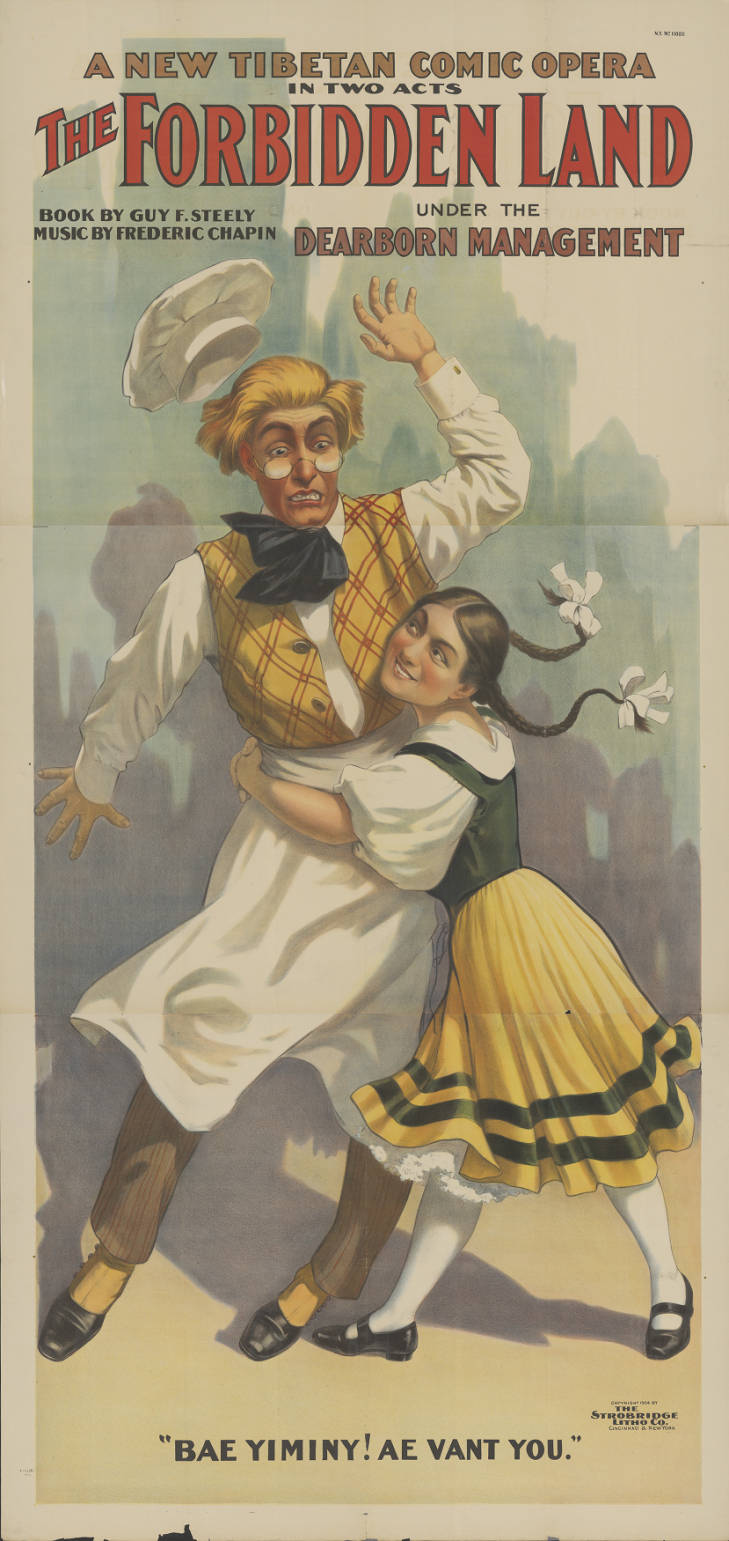
Two posters for the show and a sheet music cover.
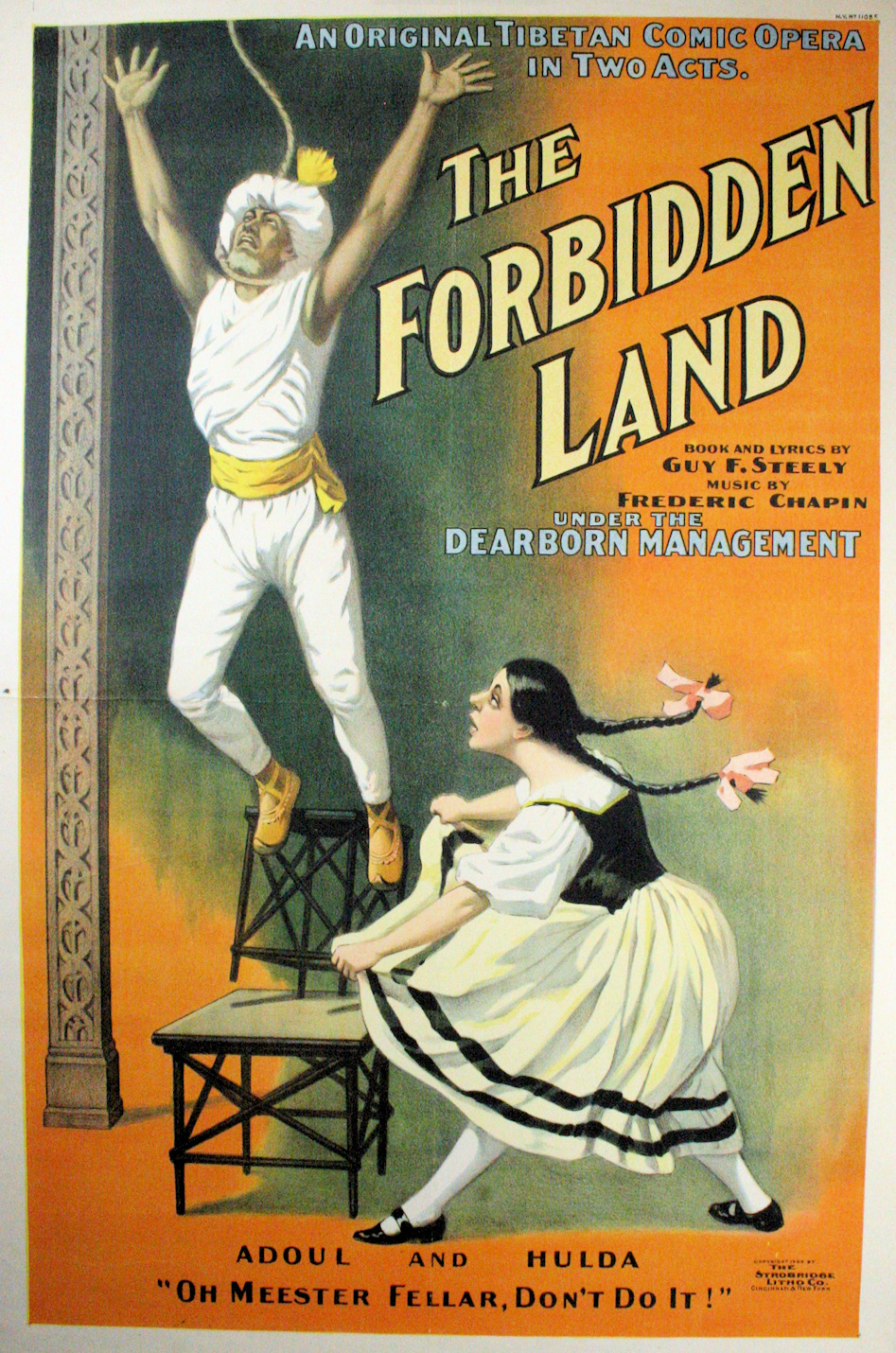
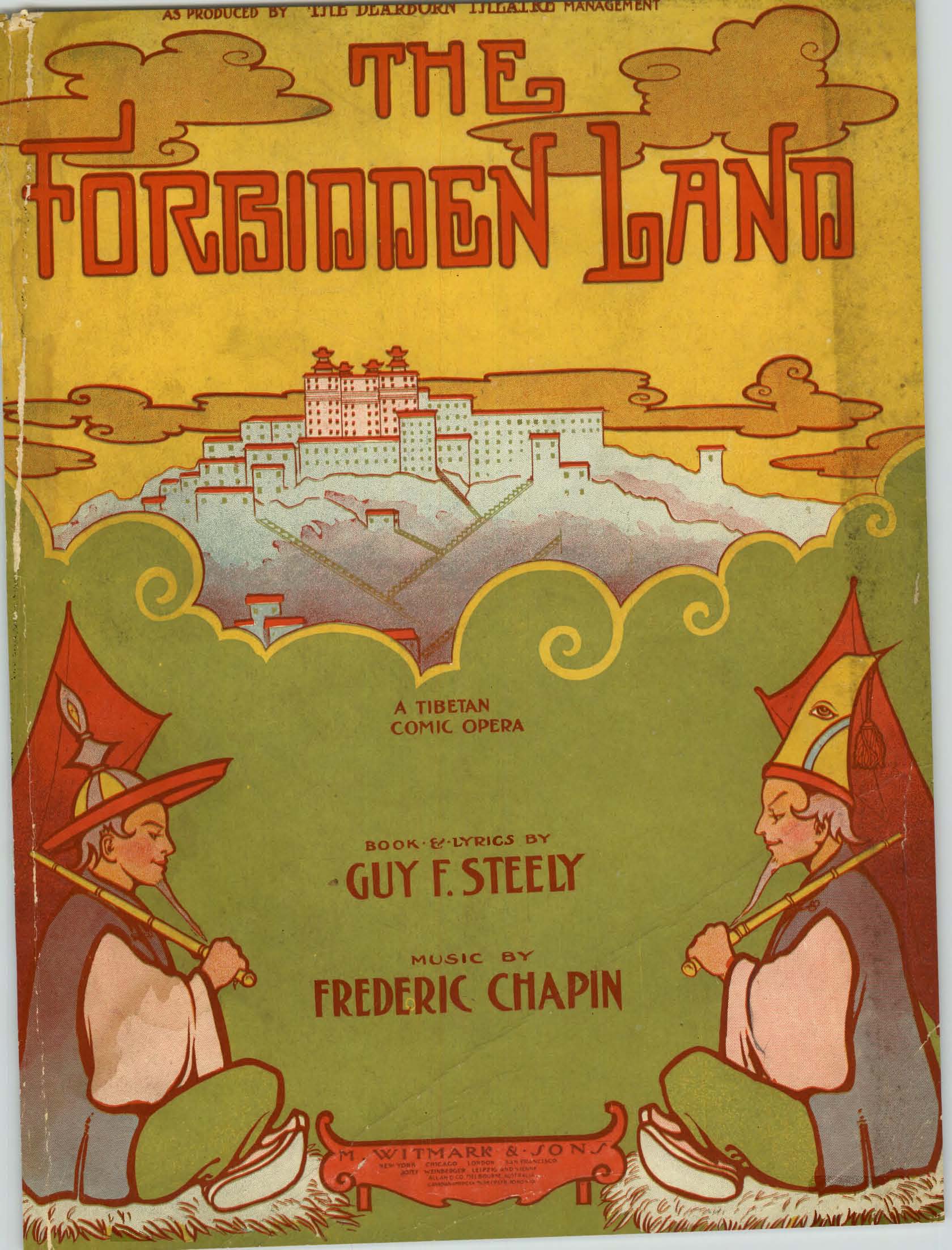
"Benjamin Barclay, the breakfast cereal tycoon from Battle Ax, Michigan (the great Kellogg interests were centered in Battle Creek), takes his niece Dorothy Fairfax, on a voyage to The Forbidden Land of Tibet. A handsome young Englishman, Tom Wilkinson, accompanies them. Their party is taken prisoner and told it will be released only if Wilkinson consents to marry Mina Doma, daughter of the Tibetan potentate. Kinkaboo, executive head of the Amalgamated Association of Asiatic Robbers, smuggles a machine into prison. The contraption allows the group to escape."(Footnote: Bordman, Gerald, Norton, Ricard, American Musical Theatre Oxford University Press, 2010, page 235. )
1904 looked to be a grim year for Chicago theatre managers following the deadly fire at the Iroquois at the end of December of 1903 in which at least 603 people lost their lives. Pessimistic managers were astonished when, with the arrival of summer, they were drawing bigger audiences than they had been during the winter and spring. The Dearborn company was doing well with Richard Carle's The Tenderfoot, which Frances would do in a revival in a few years. The company changed the name of the Dearborn Theatre to the Garrick and put The Forbidden Land into the works to open at the Illinois Theatre. It opened on July 4, 1904, running for about six weeks to the middle of August and then on tour, playing in Bloomington, Illinois, St. Paul, Minnesota, Kansas, Nebraska and other houses in the Midwest.
The book was by Guy Floyd. Seeley, a local man from Watseka, Illinois whose papers, including the score and photographs are at Guy Steely Collection of The Arizona Archives The score is also downloadable at UR Research - The Eastman School of Music - Sibley Music Library. I don't imagine that it would be well received today.
Frances was cast as "Motema" and the Chicago Tribune reviewer seemed to like the thing: "The pleasant peculiarity of last night's performance, moreover, was that in spite of the apparent thinness of the entertainment it was not a bore." The full review is here with a good deal more description of the play and the cast list.
The Jolly Baron - 1904
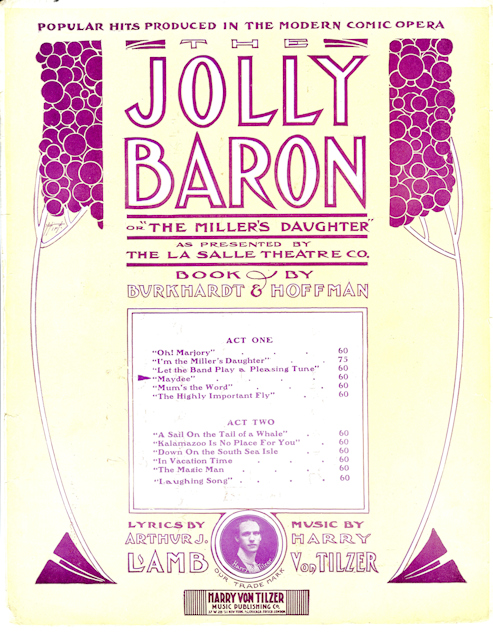
Sheet music cover to "MayDee".
When the musical opened at the LaSalle Theatre on Tuesday, September 13, 1904 the both the Inter Ocean and the Tribune reviewers were amazed at what happened at the end of the first act. When the curtain fell it rose again, the ushers came down the isle with bouquets of flowers which were handed out to the cast members by name, the audience going wild with applause.
The play was The Fisher Maiden with some of the sex and music altered. The Fisher Maiden had played in New York for little under a month in October of 1903 and was unliked, but reworked into The Jolly Baron. The story deals with a young man, Billy Baron, who is in love with a young lady named May whose father wants his daughter to marry a man with title. The efforts of the young couple to make their own marriage arrangements lead to laughable moments.(Footnote: Descriptions of the story are sparse indeed. This one is from the 1905 touring show as described in the Montgomery Times (Alabama), December 23, 1905, page 1 ) While it closed in Chicago on November 20th, a new cast led by Billy Clifford was assembled in the summer of 1905, toured and played in New York in September followed by some extensive touring around the country. (Footnote: Internet Broadway Database listing for the play and cast. The Chicago cast list is from Chicago Tribune, September 14, 1904. )
At the end of act one Frances sang "Maydee," "...a tuneful cross between the prevalent Indian maiden song and the one time popular cake walk jingle, was a favorite, and a lively number, though one suggesting a wholesale theft in melody called ‘Let the Band Play’ will probably be well liked.”(Footnote: The Inter Ocean, September 14, 1904, page 5. ) Open the whole score for "MayDee"
The musical score was by Harry Von Tilzer and five of the scores are in the archives at Kent State University Library.
The full LaSalle Theatre program is online at the Chicago Public Library digital collections
His Highness the Bey - 1904-1905
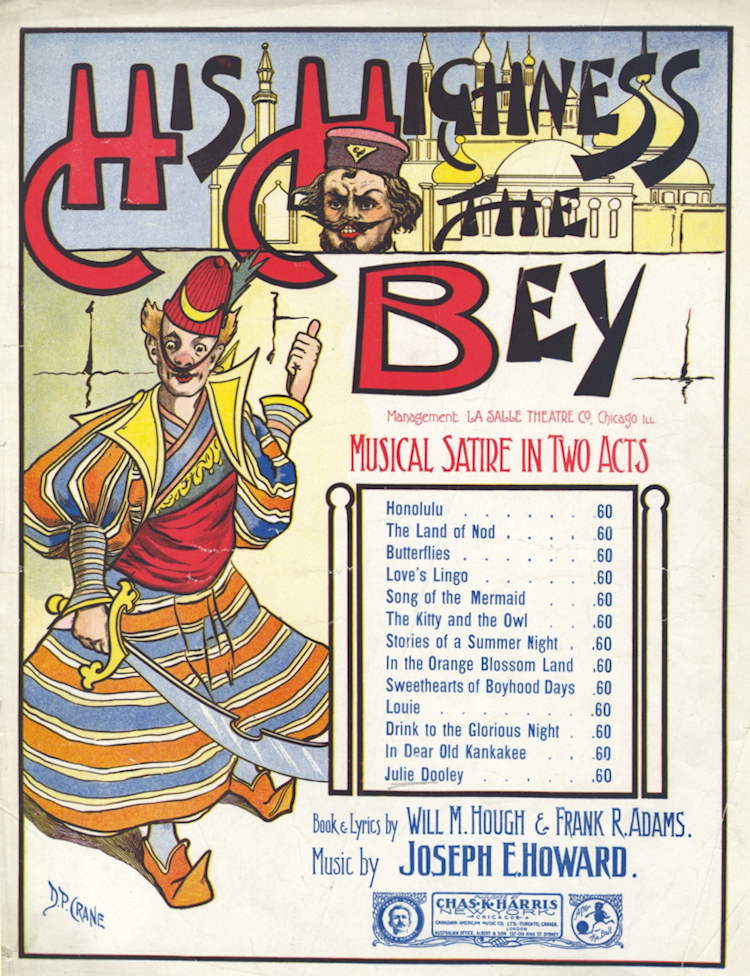
Sheet Music cover to "Julie Dooley."
A decent description of the musical is in Bordman's American Musical Theatre:
"One Chicago musical that never made it to New York was His Highness the Bey. Its failure to reach Broadway belies its importance, for
it was the first musical written by the trio who created most of the great Chicago musicals: Will M. Hough, Frank R. Adams, and Joe Howard. Of course,
Howard had already made a small name for himself, nationally as well as locally. Hough and Adams were still students at the University of
Chicago. On 21 November their classmates packed a La Salle Theatre that had been drastically rebuilt on orders of the Chicago fire department.
The story the collegians told began with the announcement that the Bey has fled his country in fear of an enemy attack. An new leader must be found. Who should
wander innocently into the crisis but a bandmaster from Kankakee, Louis Wertzelheimer (Al Shean). The world tour he is making with his wife comes
to an abrupt halt when he is drafted into the job of Bey. The complications that follow find Louis prepared to arrest his spouse as an enemy spy. Luckily,
the war stops because the papers find they haven't any more room for war news. The real Bey returns, and the reconciled Wurtzelheimers are permitted
to go on their way."(Footnote:
Bordman, op.cit page 238-9.
)
The show opened at the La Salle on November 21, 1904 and ran for five months, closing March 12, 1905.
In the week before Christmas Frances introduced the song "Julie Dooley" to the show.(Footnote:
Chicago Tribune, December 25, 1904, page 15. "The new song "Julie Dooley," introduced last week by Miss Kennedy, has found favor..."
)
Copyrighted by Joe Howard the song was introduced into the stage production of The Wizard of Oz at the September 11, 1905 show at the Brooklyn Majestic theatre, the Wizard
opening Act Two singing the Irish dialect song.
(Footnote:
Swartz, Mark, Oz Before the Rainbow, 2002, JHU Press, page 144.
Copyright renewal: Catalog of Copyright Entries 1933 Musical Compositions New Series, Vol. 28, Pt3 page 107.
) The score for "Julie Dooley" can be downloaded from the UIC Sheet Music Collection and
there is a recording of it on a CD of recordings of the 1903 "Wizard of Oz" cast Available at The Hungry Tiger Press. there is an
interesting description of that musical and the CD.
The Isle of Bong Bong - 1905

Sheet Music cover
Bordman describes the play like so: “The Isle of Bong Bong was set on Lord Percy’s hunting estate in the theatrically voguish Philippines. In order to court Marjory Gray, the young American secretary of his uncle, Lord Percy changes places with his valet. At the same time, the Sultan of the floating island of Bong Bong comes ashore to court the thrice widowed Mrs. Rensselaer-Rensselaer. (ed. Frances Kennedy.) A wizard, a bandit, pirates, and a hungry offstage lion place obstacles in the lovers’ way. Everything ends happily, with the Sultan consenting to anchor his island near civilization. The show had fun with other musicals of the era and with local figures, At one point Bong Bong’s ruler speaks kindly of his ‘sometime neighbor, the Sultan of Sulu.(Footnote: The Sulu archipelago is a chain of islands in the Philippines which has been ruled over the centuries by a Sultan, the Sultan of Sulu. There was a 1902 musical comedy by that name. Nothing to do with Star Trek's Commander Hikaru Sulu. ) In the first act Marjory sings lovingly of ‘My Illinois,’ mentioning in passing ‘Clark Street ticket scalpers’ and the White Sox.”(Footnote: Bordman, op.cit. page 243. )
The show ran for three months at the LaSalle and the Powers theatres, from March 14 to June 17th. Perhaps the best review and description of the play in the Inter Ocean; the Tribune reviewer liked the show despite its lack of plot. With a new cast the show began touring with a performance in Detroit in September and would continue that season and again in the 1906-1907 season touring largely in the Midwest.
The complete score of 88 pages is Stanford University Libraries as well as The University of Wisconsin Libraries but not online in either case.
The Yankee Regent - 1905
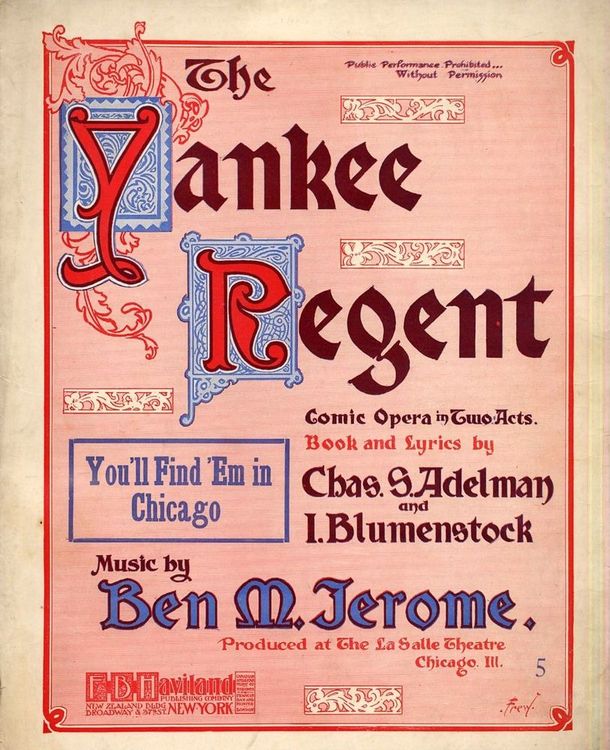
Sheet Music cover
A handsome Chicago barber is made regent of the German principality of Wiener because he is the 32nd cousin, twice removed, of Princess Olive. Olive must choose between the Chicago barber and a prince, or abdicate. She chooses the handsome American and they live happily ever after. (Footnote: Bordman, op.cit. page 247, and reviews in the Tribune and the Inter Ocean. )
The Yankee Regent opened at the La Salle on August 12, 1905 and closed December 1st. In the spring of 1907 it was revived with a new cast and went on the road touring extensively in the Midwest and as far as California, even returning to Chicago to play at the Garrick for two weeks in the summer. The show finally ground to a halt in September of 1908 in Fort Dodge, Kansas when the leading lady got appendicitis, the show was out of money and all but three members of the cast were stranded there. (Footnote: "Yankee Regent' Co. is Stranded," The Courier (Waterloo, Iowa), September 15, 1908, page 2. )
The Umpire - 1905 to 1906
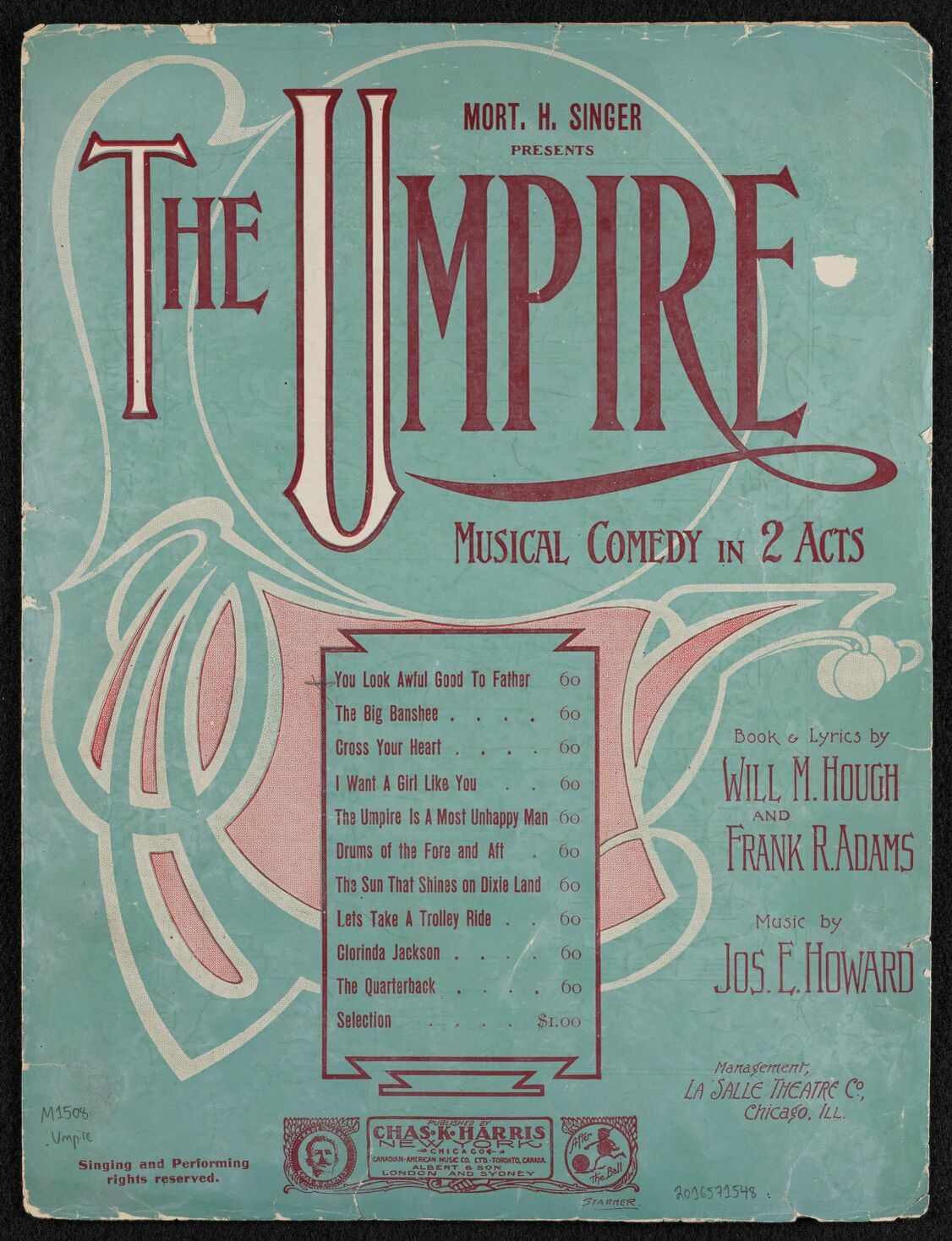
Sheet Music cover
America's new found passion for baseball corresponded with its disdain for the umpires. This play was the among the first, or possibly the first, that took that contempt to the stage. Johnny Nolan, the character, makes a controversial call which inspired so much venom that he had to flee all the way to Morocco. While there he falls in love with a female athlete while he's officiating, of all things, a football game. (Footnote: Katz, Jeffery, Plie Ball!: Baseball Meets Dance on Stage and Screen, 2016, Online preview at books.google.com., page 41. And Bordman, op.cit. page 253. )
The day after The Yankee Regent closed The Umpire opened on December 2, 1905 at the La Salle and ran for 304 performances to June of 1906, having set a record in April for the longest running play in Chicago theatre history when it passed 204 in April of 1906.(Footnote: "Some Long Runs in Chicago Houses," Chicago Tribune, April 8, 1906, page 79 ) Whether it went on tour I haven't been able to determine, but likely it did with another cast.
The song "The Umpire is a Most Unhappy Man" was popular and had a revival some 40 years later thanks to its appearance in the 1947 Lloyd Bacon film, "I Wonder Who's Kissing Her Now," the biopic of Joe Howard starring June Haver, although the song in the movie is called "How'd You Like to be an Umpire."
Thanks to the University of California Santa Barbara's Cylinder Audio Archive you can listen to a 1906 rendition of the song recorded by Edward M. Favor:
There is another recording, by Bob Roberts of this song at the
Library of Congress.
A Knight for a Day - 1907 to 1908
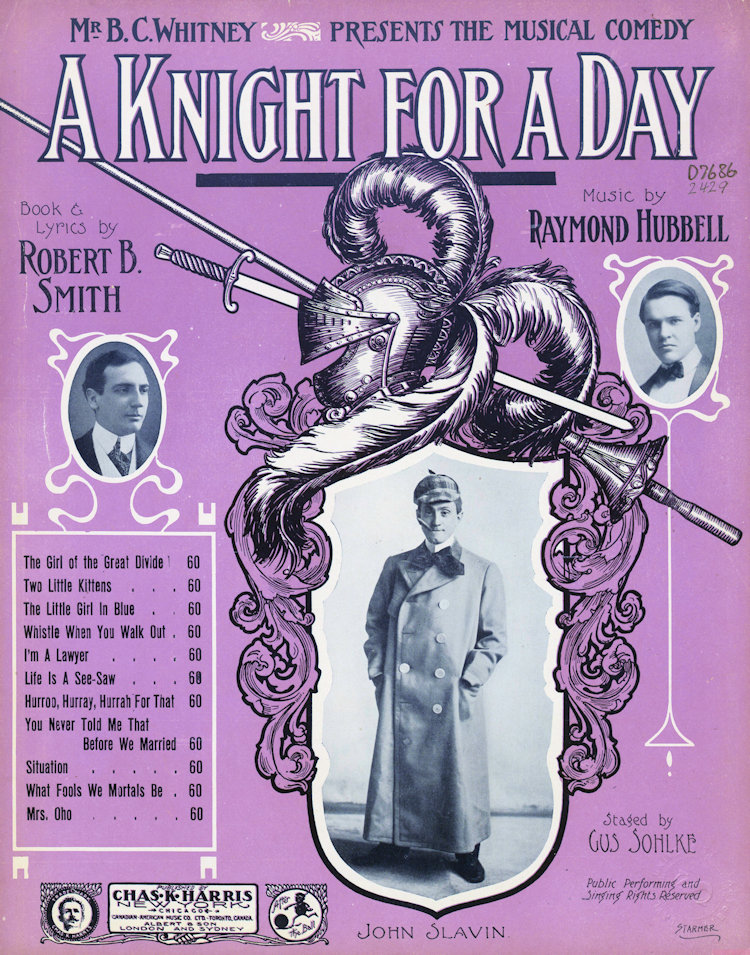
Sheet Music cover
Opening to a packed house in Chicago, the musical offered “uncommonly good entertainment” with songs around a story about “… -two lockets have wandered into strange hands and their recovery by the right people is essential to these two people getting married, a waiter disguises himself as an English knight and with his waitress bride goes to Corsica on his wedding tour.” There is much more description of the story in the Chicago Tribune review by W.L. Hubbard on this website.
Another play born in Chicago that went to New York, but with only a few of the original cast members. It opened at the Whitney in Chicago on March 30, 1907 and ran
in Chicago until February 29, 1908 with its 500th performance.(Footnote:
Inter Ocean, Feb 17, 1908)
). At least two of the cast went to New York where it ran for 176
performances at Wallack’s Theatre on Broadway, opening December 16th.(Footnote:
“Chicago Play in New York,” Chicago Tribune December 19, 1907, page 8;
Also: Internet Broadway Database (IBDB)
) Having taken a year off to have her son, Frances joined the Chicago cast on
July 28th, taking Mayme Tayor’s role of Mme. Woodbury who reportedly went on vacation but eventually joined the Broadway bound cast. A revival would open in Australia in July
of 1910.(Footnote:
Australian Variety Theatre Archive > Works [Legitimate Music Theatre > Works: 1900-1935.]
)
In a curious aside, a talented baseball player who some think would have been in the Hall of Fame, quit baseball that year to marry Mabel Hite, who played Tillie Day in the musical both in Chicago and New York. While he did return to baseball, a broken ankle another reason for quitting in 1907, he went on to an acting career following his retirement from baseball.(Footnote: See : Mike Donlin's Wikipedia article )
The Three Twins - 1908-1909
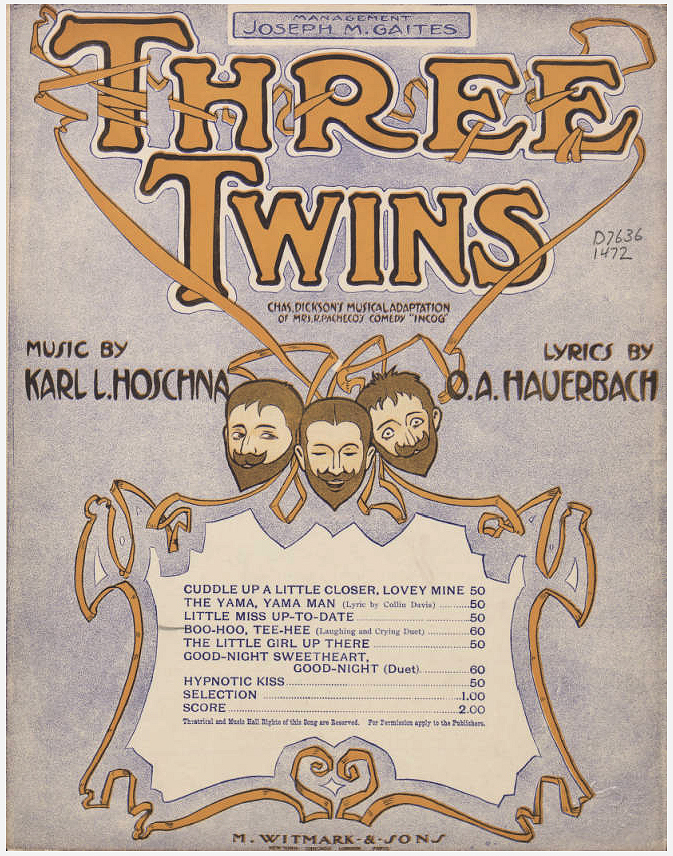
Sheet Music cover
Before the opening at the Whitney the cast performed out-of-town rehearsals in Peoria. A month later the Chicago Sunday Tribune did a delightful feature on the cast and its travel:
"On the Road With a Comic Opera Company:
Chicago Tribune Sunday Magazine Feature.
Or download PDF from a new window.
The play opened on March 7, 1908 at the Whitney with Frances playing the part of Mrs. Dick Winters, a part that she would stay with through its Broadway production. Closing in Chicago in June it moved to New York to the Herald Square Theatre and then to the Majestic after a fire. It ended the next year on March 20, 1909 after 289 performances on Broadway (Footnote: Internet Broadway Database, "Three Twins" ) followed by a fortnight in Brooklyn. The show for that cast was over, but the play would be produced over the next years around the country.
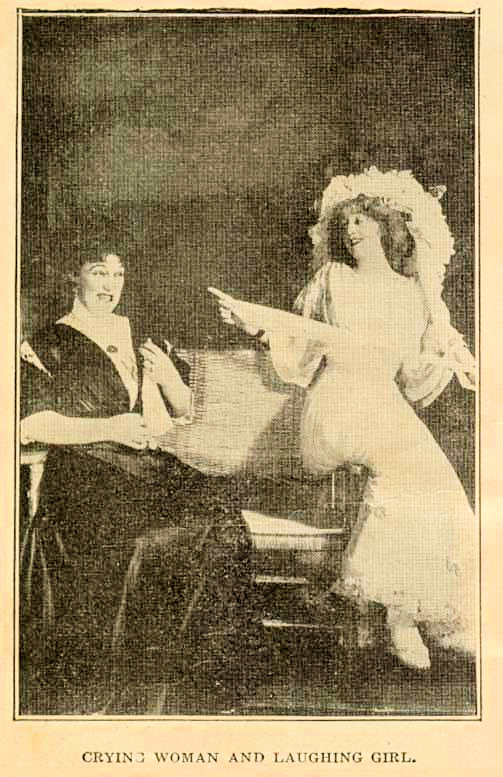
It was a smash hit and produced the popular song, “Cuddle Up a Little Closer,” which would be sung through the years by Doris Day, Bing Crosby, and Dean Martin to name a few. Another favorite song was “Yama Yama Man.” Frances sang the song “Boo Hoo! Tee Hee!” with her co-star Bessie McCoy and a chorus of girls. She was loved in New York, especially her “weeping scene” of which a reviewer in the New York Evening World Daily Magazine wrote, “It is to be hoped that Miss Frances Kennedy will never be cured of crying. As a weeping wife she is a joy. The part may be hard on her face, but her face certainly knows its stage business.”(Footnote: NY Evening World, June 17, 1908, page 15. ) It is likely her in this picture with Bessie McCoy during the "Boo Hoo! Tee Hee!" song.
While first night reviews are often critical because the performance is, well, first night, at least they give some description of the story, which is likely missing in subsequent months. The story is an ancient farcical theme of mistaken identity when, in act one set on the beach at “Sea View,” a young man, denied pursuing the girl of his dreams, disguises himself with a wig and whiskers from a picture he picks up from the grounds around a hotel. When the owner of the photograph, a weak brained and excitable husband, is expected by his wife, and a third young man, the husband’s twin brother, puts in an appearance, making for three identical men, all hell breaks loose with wives and sweethearts not being able to tell who was who and always embracing the wrong man. The complications are noisy and all three men wind up in an insane asylum for act two set in the reception room of the sanitarium. Act two suffers from a long, boring monologue after the fun of the first act according to both reviewers.(Footnote: Chicago Tribune, March 9, 1908, page 8 and Chicago Inter Ocean, March 8, 1908, page 8. ) Ten numbers are featured in the musical, and, as mentioned, one becomes very popular in the decades following.
Here's an old time recording of "Cuddle Up a Little Closer:
"Gems from the Three Twins" at the Library of Congress National Jukebox:
The picture above of the crying Mrs. Dick Winters is one of many from the New York performance at the Bayles-Yeager Online Archives of the Performing Arts. It is likely Frances in the picture.
The Tenderfoot - The 1909 Revival
Sheet music cover to "My Alamo Love":
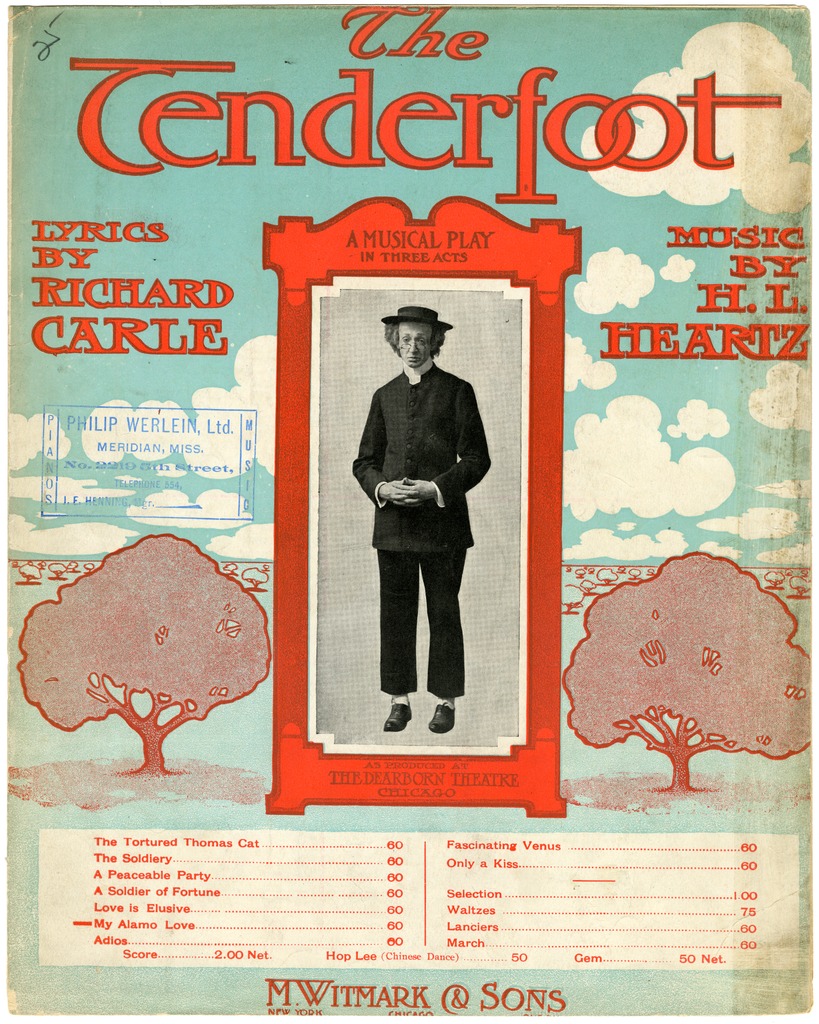
Lyrics to "Gibson Girls"
Here’s a typical girl you cannot fail to recognize!
Slender, willowy, too, Tall and billowy too,
Intellectual forehead and a pair of dreamy eyes;
Shoulders that are sloping and a waist that’s rather slim,
Hands and fingers shapely as can be;
Dainty little tootsies and an ankle neat and trim,
Airy, fairy “Gibson Girls” are we!
[Refrain]
Everything we see appears to bore us!
Including all the chappies who adore us!
Tho’ they struggle and they try
To attract our lazy eye
Their earnest efforts only seem to bore us!
[Dance]
Airy fairy “Gibson Girls” are we.
Frances took on the role of Flora Jane Fibby, an authoress, for a one month revival at the Colonial Theatre of Richard Carle’s hit from the 1903-1904 season which played at the Dearborn Theatre; the Dearborn became the Garrick in 1903 during that run of the musical. The revival opened on June 1, 1909 and closed July 24th.
Flora, in act two sings “Gibson Girls” with eight young ladies who are in the cast as “Gibson Girls.” The lyrics are provided here.
A 1903 description of the musical read, “Richard Carle, the librettist, has taken his own measure in the part of Professor Zachary Pettibone of
St. Johnsbury, VT., a traveling tutor for a party of young ladies. The professor, while at dinner, is neatly lassooed (sic) by cowboys, and dances under
the stress of revolver shots. He has a large share in the comedy, but figures little in the plot, which concerns, chiefly, a cavalry Colonel (Edmund Stanley, the tenor,)
and a Texas heiress (Miss May De Sousa). Gilbert Gregory has been provided for in the part of Sergeant Barker of the Texas Rangers.
The life of this Texas border and its mixed population are relied upon to furnish material that is new to musical “shows.” Mexicans, cowboys, soldiers, Indians,
and senoritas people the play, making effective costuming possible. Harry L. Heartz, composer of “Miss Simplicity,” has written some twenty musical numbers.”
(Footnote:
Chicago Inter Ocean, April 3, 1903
)
The program for its fourth week at the Dearborn in 1903 can be accessed at The Chicago Public Library Digital Collections.
The complete musical score to "The Tenderfoot" is at Archive.org. "Gibson Girls" number is at page 74.
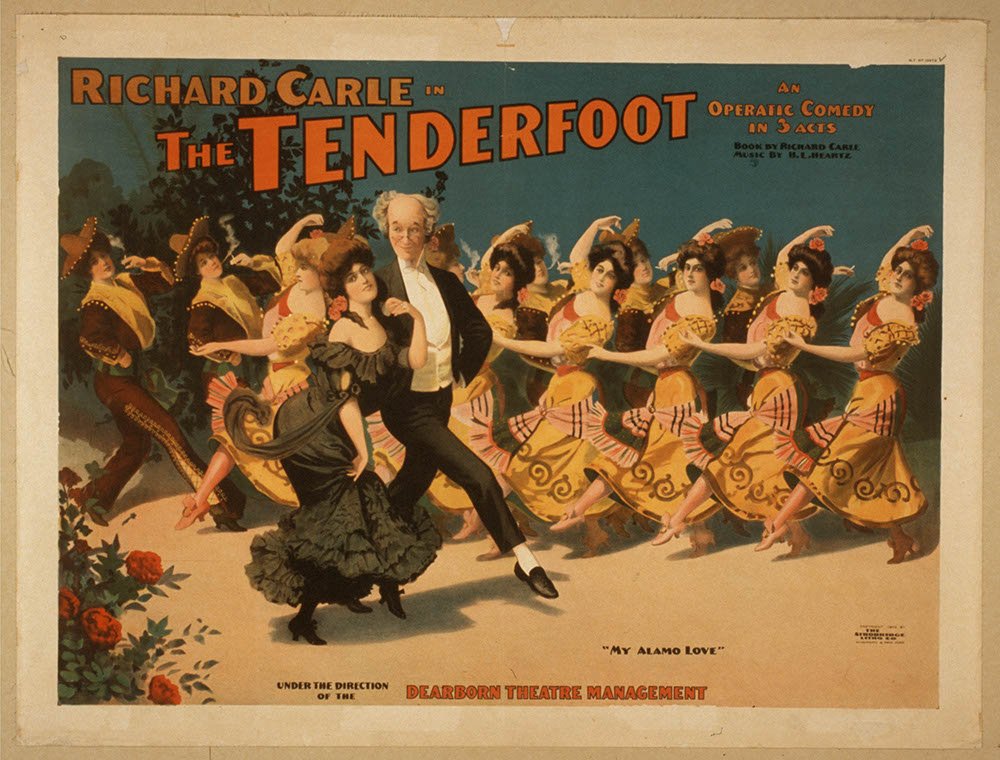
Both the poster and the sheet music cover are from the earlier, 1903-4 production.
The song "My Alamo Love" became popular; the sheet music is still as of this writing available from Amazon.com.
Strangely enough, a movie of the same name starring Joe E. Brown and Ginger Rogers was made in 1932, and while it seems to bear no resemblance to Richard Carle’s musical, it claims to be based on his story. More about the movie at The peoples procrastinator blog.
Midi files, the orchestration, along with the 1903 cast and song listing is at The Gilbert and Sullivan Archive at the American Musical Theatre.
The Belle of Brittany - 1909
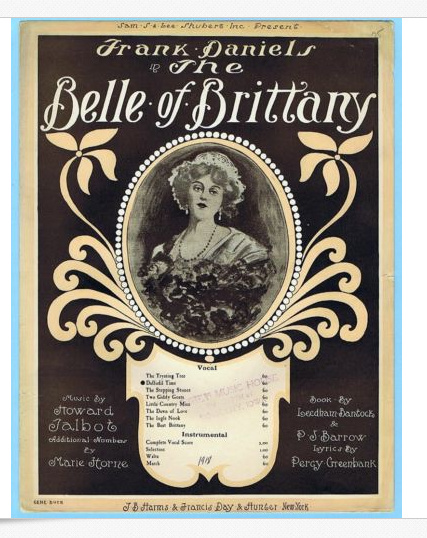
Sheet Music cover
Evidently a big success at the Queen’s Theatre in London, the Shuberts brought the play as a vehicle for Frank Daniels to New York in November of 1909 where Frances opened with the cast as the miller’s wife Madame Poquelin. The show opened November 8, 1909 at Daly’s Theatre and closed exactly two months later after 72 performances there. While reviewers claim an ensemble of some fifty people, there are thirty-two listed at the Internet Broadway Database for the show, including chorus members. It did go on tour to Buffalo, Kansas City and other stops through the end of the 1909-1910 season.
Was evidently great fun despite lacking in plot, which most musically comedies were. Set it Brittany in the 18th century it involves Frank Daniels as the impecunious Marquis de St. Gautler who wants his son to marry his wealthy ward, Mile. Denise de la Vire. The son, naturally, wants Babette, the daughter of the miller Poquelin who broke off her engagement to a Paris chef on the day of her marriage. But, as the New York Times writes, “…the plot has nothing to do with the show, and is not permitted to interfere with the fun for a moment.”(Footnote: NY Times, Nov 9, 1909. Plot summary from the Times and the Buffalo Sunday Morning News, November 14, 1909. )
"Gems from the Belle of Brittany" at the Library of Congress:
Jumping Jupiter - 1910
.jpg)
Sheet Music cover
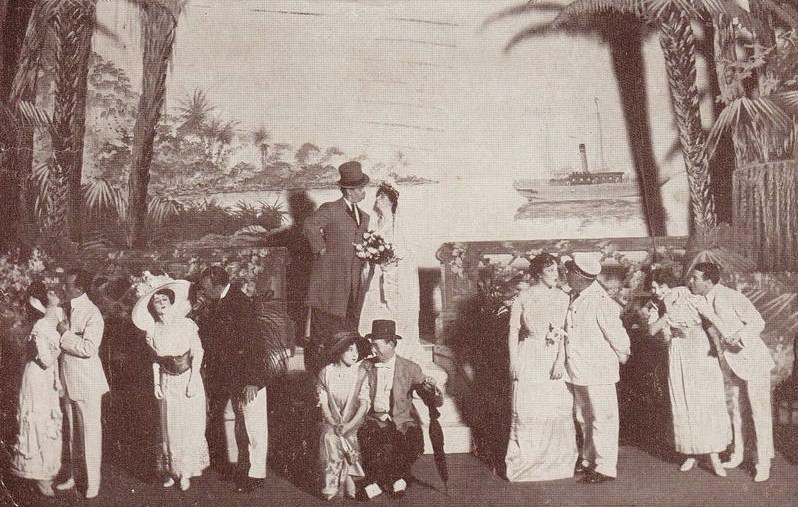
The cast on stage.
This musical had a long, long touring run from when it opened in Chicago on August 13, 1910 until it ended in Pennsylvania in April of 1912, appearing on Broadway for 24 performances in March of 1911. Frances, however, left the cast on October 11 to join the cast of The Chocolate Soldier. An interesting take on the show is a blog about Helen Broderick (1891-1959) who was on the cast in New York, and likely in Chicago as well.
Reviewers, always intent on judging performances and the musical, rarely describe the action,(Footnote: A good example being "Jumping Jupiter Amuses," The Sun New York, March 7, 1911 ) but here are two for Jumping Jupiter. One is a contemporary description, the other from a recent chronicle of musicals:
-
"The piece was about a young artist who deserted the Purple Lady, his model, to marry the daughter of a retired army officer. Of course, the Purple Lady arrived at an inopportune moment and was introduced as the wife of an accommodating friend. The complications were increased when the real wife arrives upon the scene and has to take the place of a servant.
In the end everything turns out right and the young lovers marry, and, we hope, live happily ever after. However, judging by the reception that the piece received last night, they are not destined to remain very long at the New York theatre. It is a pity, for Ricard Carle and Edna Wallace Hopper are two exceptionally popular stars, who worked hard to bring the piece into the golden fields of popularity."(Footnote: Brooklyn Daily Eagle, March 7, 1911, page 12. ) -
“Robert Winthrop tires of his wife, Connie, and offers her a large check if she will leave. She tears up the check. But unknown to Winthrop, Connie has been posing as Professor Goodwillie’s wife. When the real Mrs. Goodwillie and the professor (Carle) arrive, Winthrop sees another way out.”(Footnote: Bordman, op.cit., pages 307-308. )
Sheet music appears in various places on the internet, and in this case, the actual piano accompaniment:The piano to two songs, “Kiss Me My Honey, Kiss Me” and “’Thank You, Kind Sir!’ Said She” can be heard at musicnotes.com
The sheet music for "Little Girl, I Love You" can be had at The Library of Congress.
The Chocolate Soldier - 1909 to 1911
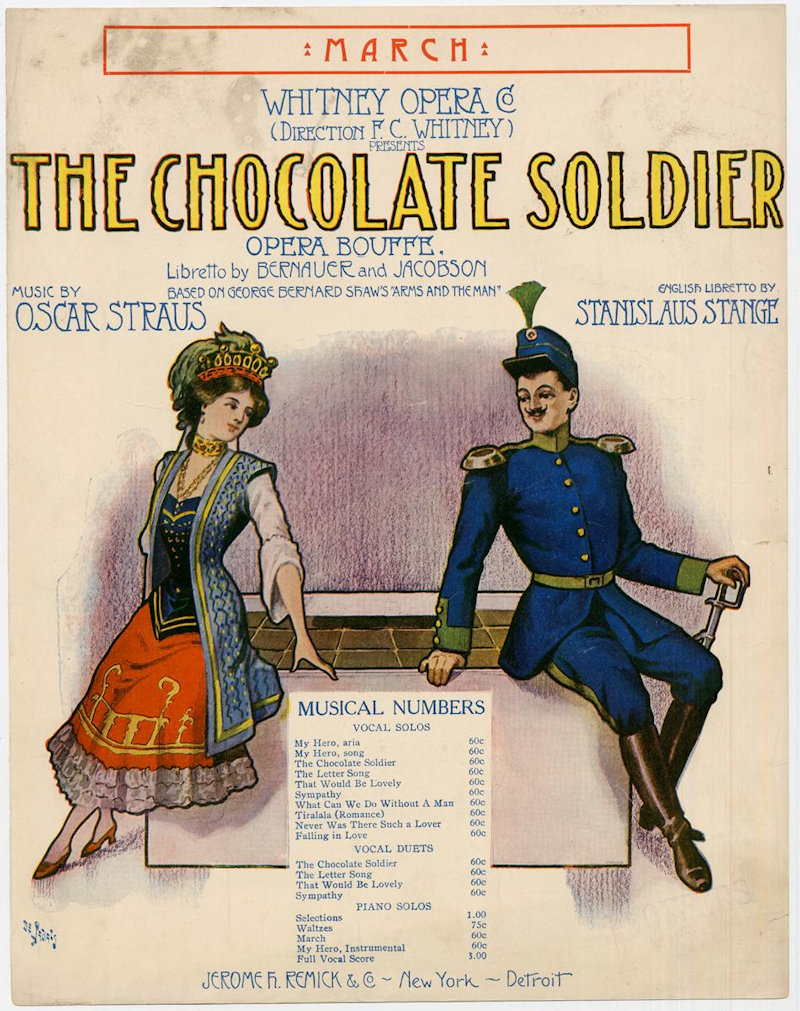
Sheet Music cover
Producer Fred C. Whitney (1865-1930) had perhaps his greatest hit with The Chocolate Soldier. The New York cast, which opened at the Lyric on Broadway on September 13, 1909, ran for 295 performances in three different houses on Broadway, ending on May 28, 1910.(Footnote: IBDB, Internet Broadway Database. ] ) The Chicago cast opened at the Garrick Theatre on September 25, 1910 and ran there until January 7, 1911 when it went on tour, with occasional out-of-town performances during the Chicago run. (Footnote: Played one performance in Davenport’s Burtis Theatre on November 7 – Quad cities newspapers. ) Frances, who left Jumping Jupiter, joined the cast on October 11th playing Aurelia Popoff, the mother in the play,(Footnote: Chicago Inter Ocean, Dec.4, 1910 ) and left in April when it was in Ottawa, Canada when she was about seven months pregnant. There was a production in Boston during this period as well as England. It was revived in 1912 in Chicago at the American Music Hall and had numerous revivals on Broadway.(Footnote: IBDB, Internet Broadway Database list of performances and revivals. )
The show, with music by Oscar Strauss, was based on George Bernard Shaw’s play “Arms and the Man,” produced first in Germany. There is a very detailed description of the play at The Guide to Musical Theatre from which this synopsis is copied: “When Lieutenant Bummerli, a Swiss mercenary in the Serbian army, takes refuge from his Bulgarian enemies in the house of a Bulgarian general - to be precise, in the daughter's bedroom - he sets hearts a-flutter, almost compromises three ladies and then ruins the daughter's wedding to a Bulgarian soldier-hero by being recognized as the fugitive! This is just as well because he and Nadina, the daughter, were destined for each other anyway.”
The Red Petticoat - 1912-1913
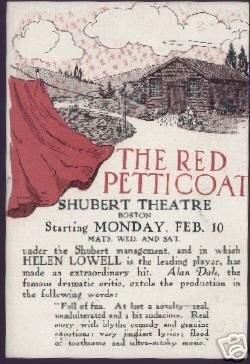
Small flyer for the Boston performance.
The Red Petticoat, Jerome Kern’s first full score, book by Rida Johnson Young who became famous for her Naughty Marietta, opened at Daly’s Theatre on Broadway on
November 13, 1912 and closed at the Broadway Theatre on the 4th of January, 1913 after 61 performances. The musical was a lyric version of Ms. Young’s flop of the previous year, Next.
Frances, in the role of “Sage Brush” Kate, opened the show singing “Sing, Sing, You Tetrazzini, Sing” with the chorus.(Footnote:
Program - Musical Numbers in the Shubert Theatre program. "Sing, Sing, You Tetrarzzini, Sing".....Regan, Kate, and Chorus. And Program - Cast.
) Two months on Broadway the show hit the road to Brooklyn,
Boston and then west to Chicago in the American Music hall in March, ending in Buffalo at the end of March. The Chicago Tribune reviewer called it “Fetching and Funny” and provided a description:
"Sing, Sing, You Tetrazzini, Sing"
Frances opened the first act with the chorus singing "Sing, Sing, You Tetrazzini, Sing" and while this audio isn't her, its pretty fun although I have no idea what it means in the show, but it no doubt refers to Luisa Tetrazzini (1871-1940), an internationally famous coloratrua soprano.
It's Jeanne Lehman & Hugh Panaro, with the BBC Concert Orchestra from the YouTube Video.
“The story centers around Sophie Brush, a spinster and lady barber, who comes to Lost River, Nev., with eight young manicurists and regenerates things in general. After she has been
there a few days all the boys are wearing fussy neckties, shaving twice a day, and getting their fingernails polished every idle moment.
The gaming hero becomes unpopular
with the citizens, who allow they are going to string him up. Sophie knows, after a certain girl has told her, that the gallant young exponent of chance is not getting a square deal,
so she hides him in the kitchen. The stage coach driver intrusts (sic) a box of gold to Sophie, which she also puts in the kitchen. The Mexican lifts it. Naturally the majority of the people think,
when they drag Jack Warner, the gamester, from his hiding place, that he took it. But Sophie’s parrot (Mary Garden) has seen the foul deed done and right before everybody pipes out the words that put
Bad Jake “in Dutch.”
Jack Warner goes back to the kitchen, not yet wholly freed from suspicion. He digs a tunnel to freedom, and in so doing strikes the biggest vein ever known in them there parts.
So everybody cashes in with the final curtain.”(Footnote:
Chicago Tribune, March 4, 1913.
)
The program is for the week of February 17, 1913 at the Shubert Theatre in Boston. (Click on the little box lower right to see it full size and zoomable at archive.org.)
Some details of the Broadway run is at The Internet Broadway Database for The Red Petticoat.
A Broadway Honeymoon - 1913
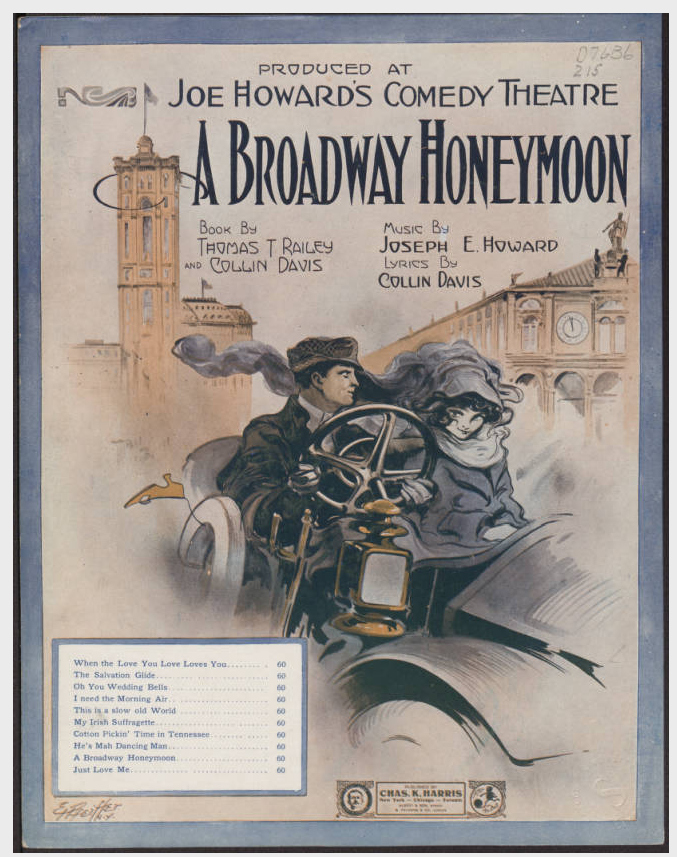
Sheet Music cover
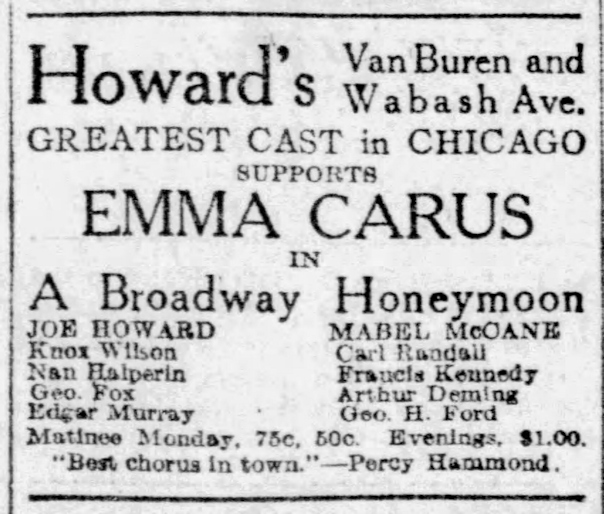
Once again Frances would work with that icon of musical comedy and vaudeville, Joe Howard, in what was pretty much a flop. Joe Howard had leased the Whitney Theatre at Van Buren and Wabash and renamed it Joe Howard's Comedy Theatre. The show opened October 3, 1913 and ran until Thanksgiving when it went on the road for a few performances to the south. Sophie Tucker wanted to do the show but withdrew during the early rehersals over her prominence in the show.(Footnote: Chicago Tribune, August 26, 1913, page 10. )
I discovered little as to what this show was about except a brief description that Joe Howard's character gets married in New Jersey but returns to Broadway where his ex-wife still is around. A "theatro-legal shark" assures him he could have a second wife in Jersey but not in New York. "Thus do man's laws add to the gayety (sic) of musical comedy."(Footnote: Chicago Tribune, October 4, 1913. )
Reviewers in Chicago and on the road were generally kind only to the singing and gayety of the cast, but otherwise it was a "hodge-podge of every old thing..." (Footnote: Kansas City Globe, December 1, 1913. ) The problem evidently was with the libretto for, while the songs were not to become popular, they were many and evidently enthusiastic. The show had an out-of-town premiere in Gary, Indiana on October 1st. The press around the country was more interested in the Paris designed hat that Emma Carus wore in the production than in the musical itself.
A bit of an aside on Joe Howard:
Frances Kennedy must have known him fairly well having worked with him earlier in The Isle of Bong, Bong and The Umpire.
Of the cast listing in the ad for A Broadway Honeymoon three of the people have Wikipedia articles: Emma Carus, Nan Halperin, and of course, Joe Howard. Nan Halperin was the wife of songwriter William Friedlander who would write some songs for Frances when she went out on the vaudeville circuits in 1916. It was Joe Howard who became sort of an icon of the era and in later life even had a very early TV show celebrating the "Gay 90s" in which he performs. One episode of that survives and you can watch it at The Internet Archive. It's kind of a hoot. Joe, the troubadour to the end, died on the Civic Opera house stage in 1961 while singing an encore of "Let Me Call You Sweetheart" which unfortunately for the drama involved, was not a song he wrote. He was the subject of the 1947 George Jessel film production of "I Wonder Who's Kissing Her Now" the title of song of which Joe is associated with(Footnote: After the movie was released Joe lost a lawsuit to Harold Orlob who claimed that he wrote the song but settled with only having his name put on the song. (Harry Golden, Chicago Tribune, July 23, 1961, and LA Times, May 20, 1948, page 14.) ) and my mother-in-law can still sing with all the lyrics. He was also famous for "Hello My Baby" and "Goodbye, My Lady Love."
Howard, other than being a troubadour, was not a faithful husband, reportedly married nine times.(Footnote: Frank Cullen, Florence Hackman, Donald McNeilly, Vaudeville Old & New page 534, accessed online at books.google.com Feb 8, 2019. ) His third wife, Irma Kilgallen Howard, committed suicide after a month of marriage when she found him, if one reads between the lines of the newspaper article, messing around with another woman in the Hotel Foutenelle in Omaha, Nebraska in 1916. Nonplussed, Joe went on with his act that evening saying, "It is the will of God. I must go on with my work for the public." A complete review of his tempestuous affairs to that time is in pages 1 and 3 of the Chicago Tribune, April 11, 1916.
Joe, evidently always stretching himself thin, filed for bankruptcy in the summer of 1917 owing Mabel McCane 5 grand, Sophie Tucker a grand, and the Shuberts another 5 thousand. He would be back though.
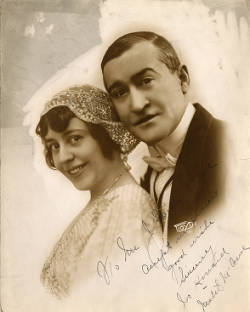
The photo is of Mabel McCane and Joe Howard from 1915. They were so close the public assumed they were married. Looks like a wedding photo to me, but...
September Morn - 1913-1914
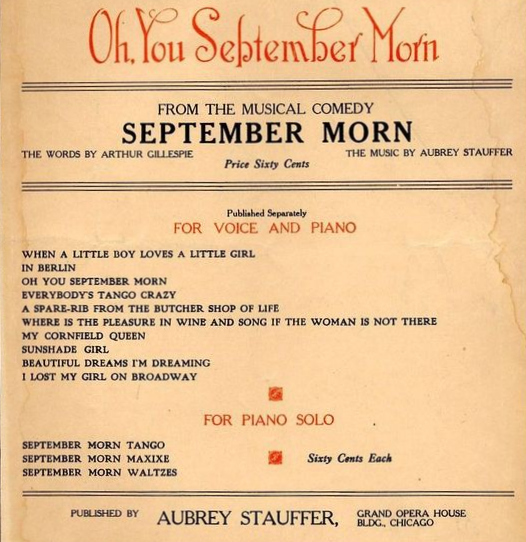
Sheet music cover.
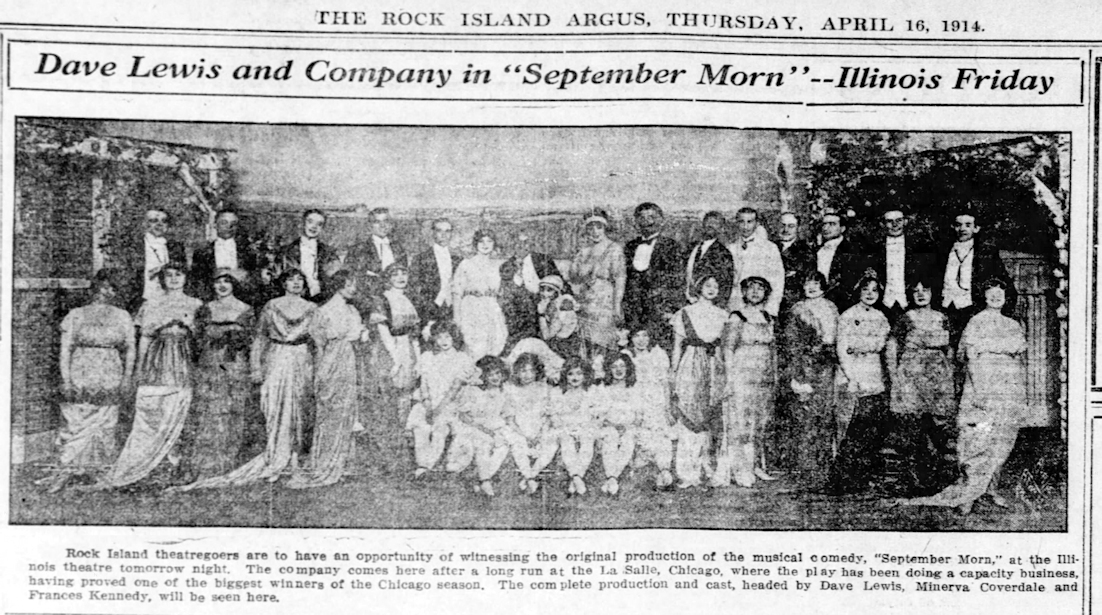
Cast photo.
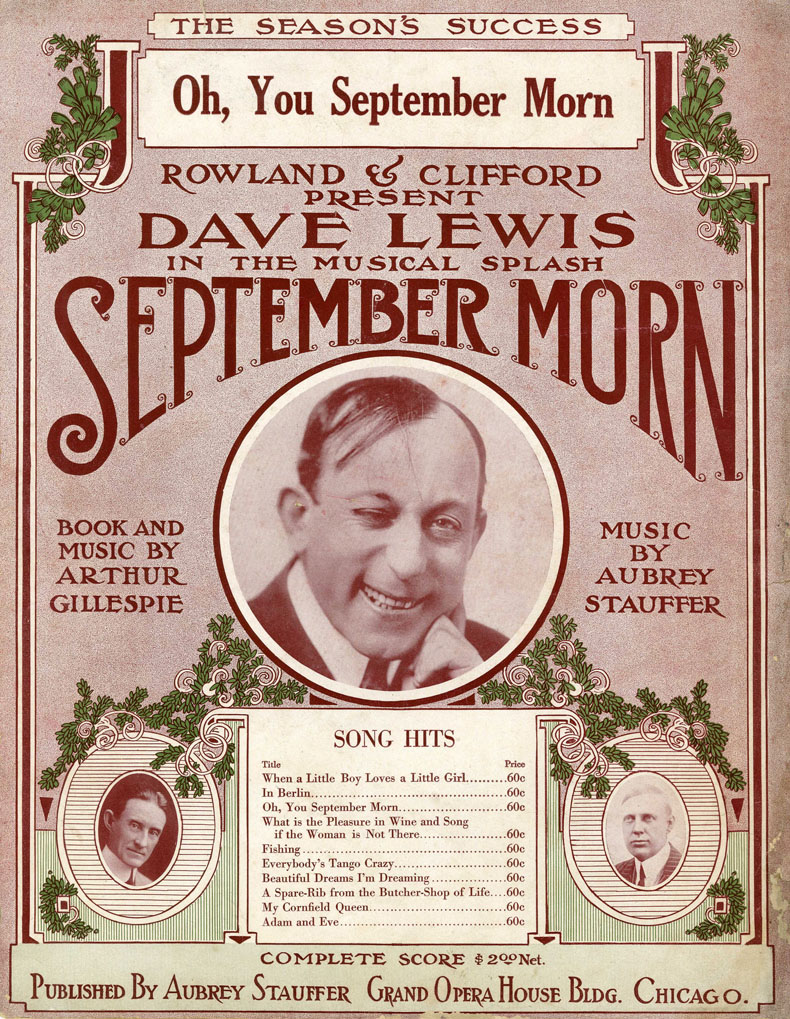
Sheet Music cover
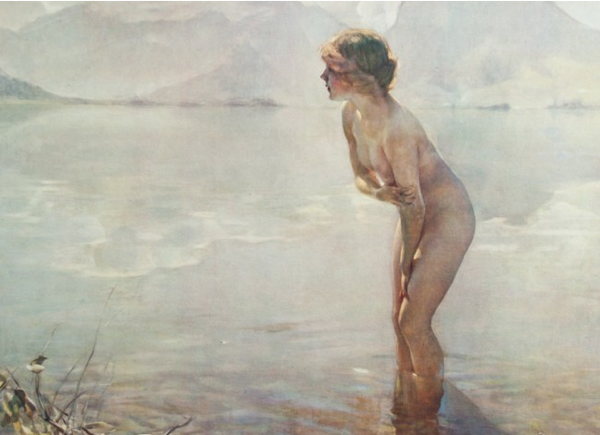
Chabas painting "September Morn"
The show, managed by Rowland and Clifford with the book and lyrics by Arthur Gillespie, score by Aubrey Stauffer, was the story of Rudolph Plastic, [ed. Dave Lewis] a would be artist “…who claims to have painted the celebrated Chabas picture called ‘September Morn’ (but in reality cannot paint the side of a barn and do it well) continually gets himself in tight places. An actress [ed. Minerva Coverdale – ‘Argentina’] claims to be the original model of the popular picture and she instructs her publicity promoter to boost her as the real ‘September Morn,’ who was not afraid to bathe in the open or the lake or whatever it was. (Footnote: There actually were a number of women who claimed to be the model for the painting. See the Wikipedia article. ) The dodging of Rudolph and the actress, both knowing they are impostors, causes a number of surprising complications. And a bluff army officer named Major Storm [ed. Edgar Murray] also gets mixed up in the affairs of the lady thespian – in fact, falls in love with her only to find that she is his wife’s dearest friend. [ed. Frances Kennedy]. This and the divers other difficulties are eventually straightened out to the satisfaction of most of the people concerned.” (Footnote: The Green Book Magazine, Vol 11, Story-Press Association, 1913, pp 879-880. Online at books.google.com - https://books.google.com/books?id=LHMhAQAAMAAJ )
The show ran for three and a half months from December 21, 1913 to the first week in April of 1914 at the La Salle Theatre with a cast and chorus of over fifty people. The libretto was almost universally panned, but everyone seemed to enjoy the music. The original cast took it on tour in the Midwest, playing in Illinois, Wisconsin (Oshkosh at the Grand Opera House), Indiana and likely other states until the beginning of summer. It is very difficult to track in the newspapers since it was born in the midst of the uproar over the controversial nude painting with that name (Footnote: Wikipedia: A very detailed examination of the painting and the controversy. ) as well as the release of a silent film in 1914 with the same name, a film plot not related to the play. The film, released in February of 1914, is reviewed in Moving Picture World.
A revival with new cast came out and toured in the winter 1914-1915 season, drawing appreciation from the reviewers for the way it “…goes with a bang and a rush, put together to amuse the muchly abused theater-going public.” (Footnote: The Michigan Daily, Ann Arbor, January 17, 1915, page 4. The official newspaper of the University of Michigan. ) The Chicago reviewers of the original cast the year before also liked the music, but Percy Hammond in the Tribune couldn’t have been more scathing: “The program at the La Salle says that the libretto of September Morn was written by Mr. Arthur Gillespie. I refuse to believe that he wrote it. I refuse to believe that any one wrote it or that it exists. It is so bad that it is incredible.”(Footnote: [Chicago Tribune, Dec 23, 1913] ) The reviewer in the Inter Ocean couldn’t figure out what was going on but liked the music.
The song “O, You September Morn” was the hit of the show, although Frances’ singing of the sentimental ballad “Beautiful Dreams I’m Dreaming” was also recommended by the Chicago reviewer; the sheet music is online at the Sheet Music Collection of the University of Illinois at Chicago. Other songs included “When a Little Boy Loves a Little Girl,” “Everybody’s Tango-Crazy,” “A Spare-Rib from the Butcher-Shop of Life,” “Where Is the Pleasure in Wine and Song?” and “The Sunshine-Girl.”
The Elopers - 1914

Sheet music cover to the song "Ev'ry Road is the Right Road."
Another play that lasted about three months opened at the Comedy Theatre at 64 E. Van Buren on June 27, 1914, moved to the La Salle on July 19th at the same time Frances replaced the lead, Clara Palmer. (Footnote: Cullen, op.cit.says the 17th but he is wrong. – The ad in the Chicago Tribune on the 27th says “Starts Tonight.” ) In his review of the opening in the Chicago Tribune Percy Hammond wrote, “Among the few facts that are to be here recorded about ‘The Elopers’ is that it is of the Chicago type of musical comedy, containing more jig than jest, with plenty of pretty and alert girls in tights and tunes easy enough for any one to whistle…In is first act four couples plan to get married, and in its last act that plan succeeds.(Footnote: Percy Hammond, “Singing and Dancing at the Comedy Theater,” Chicago Tribune, June 29, 1914, page 16.(Unfortunately the Chicago Inter Ocean, which generally had great coverage of Chicago theatre, went out of business in 1914.) )
That’s about all I’ve been able to glean as to what the play was about, but Hammond does paraphrase one joke from the play that’s funny as well as likely typical: “Was George Washington an honest man?” queries the soubrette. “They say he was,” Mr. Phillips answers, “but they always close the banks on his birthday.”
The libretto was the posthumous work of Arthur Gillespie, who had done September Morn, and G.F. Stoddard. The music was by Hugo Frey, lyrics by Frederick Herendeen. Among the songs were “Kuck-oo Clock,” “Over the Seas,” “Ev’ry Road is the Right Road, When the Right Girl is Along,”[Recording are in the UC Santa Barbara library and the Libraries of Canada in Ottawa but not online.] “Oh, You Tango Band,” “Twilight,” “You Just You,” “Whistle It.” The sheet music for these are at the Baylor University’s Frances G. Spencer Collection of Popular Music.
Curiously, during the run the theatre manager, Harry Cort, eloped with one of the cast members. And then G.F. Stoddard, a co-author of the play, eloped with Peggy Pendleton, a member of the chorus. (Footnote: Variety, July 31, 1914, page 10. )
The Lilac Domino - 1914
Little can be said about The Lilac Domino and Frances' involvement with the original Broadway Operetta that opened on October 28, 1914 and closed January 30th. She is listed in the chorus on opening night in the Internet Broadway Database which assumes that it is she given links to the other Broadway shows she appeared in.(Footnote: [IBDB, The Lilac Domino at the Internet Broadway Database. ] ) I don't suppose that she stayed with the show very long as in November she is back in Chicago singing with baritone Eusebio Concialdi at Orchestra Hall in the middle of the run of The Lilac Domino's run on Broadway. The show appeared at the Garrick in November, 1915, but by then Frances was on to Within the Loop.
Within the Loop - 1915-1916
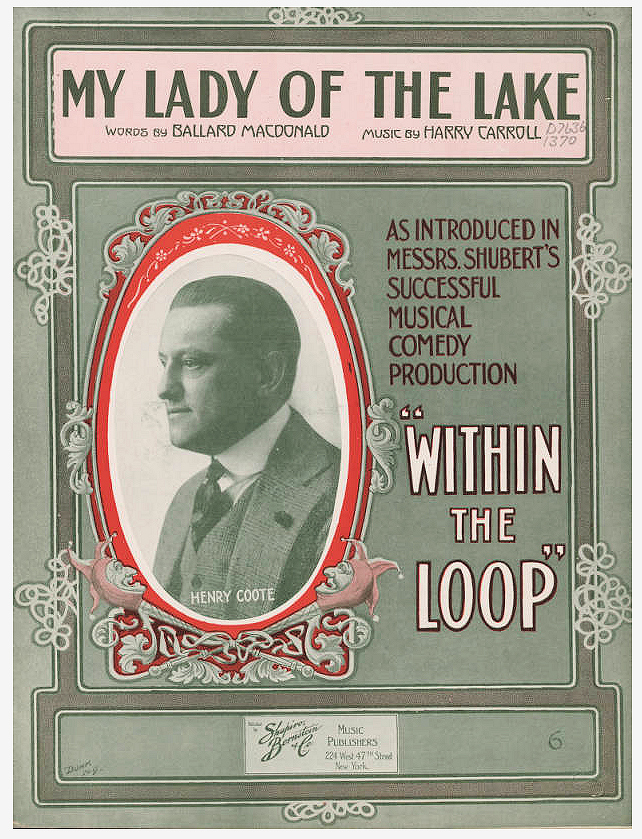
One of the only sheet music covers I've been able to discover.
Once again working with Dave Lewis Frances was a headliner when this show opened for the first time in Buffalo at the Teck on November 22 in what was billed as a revue with two acts, eight scenes, and 125 players.(Footnote: Ad. Buffalo Commercial, November 20,1915: "Opens Here Monday Night" "First Time on Any Stage of the New Musical Review of 125 Players" "Entire Company Going to The American Music Hall, Chicago." ) The New York Evening World reported on November 2nd that the Shubert brothers production had been in rehearsal for nine weeks and was almost ready to open at the Lyric in Philadelphia but the theatre evidently wasn’t finished with renovations so it opened in Buffalo. Following Buffalo it had performances in Detroit and Pittsburg before it landed in Chicago in the refurbished, and renamed, Chicago Theatre, formerly the American Music Hall, on December 29th. It played there until the 22 of January then on to St. Louis, Indianapolis, Muncie, Indiana, Cincinnati, Dayton, Ohio closing there the second week in February.
Once again, a thin plot, but one which was evidently a big hit in Buffalo. After extolling the "...the bewildering beauty to the show. The many scenes furnish abundant opportunity for sprightly acts and specialties, some catchy songs and a wealth of entertaining music," the Buffalo reviewer mentions that the play is about a wild-living, youthful millionaire who spends his last dollar seeing Broadway. Someone then tells him he's been left a legacy of ten million dollars and he starts spending all over again only to discover that the it isn't true. (Footnote: "'Within the Loop' A Great Show," Buffalo Enquirer, November 24, 1915, page 3. ) A long review, again without much of a description, appears in Variety calling the show a disappointment. Variety also reported later in that issue that although the revue was being treated nicely in the papers, it wasn’t drawing the audiences expected.
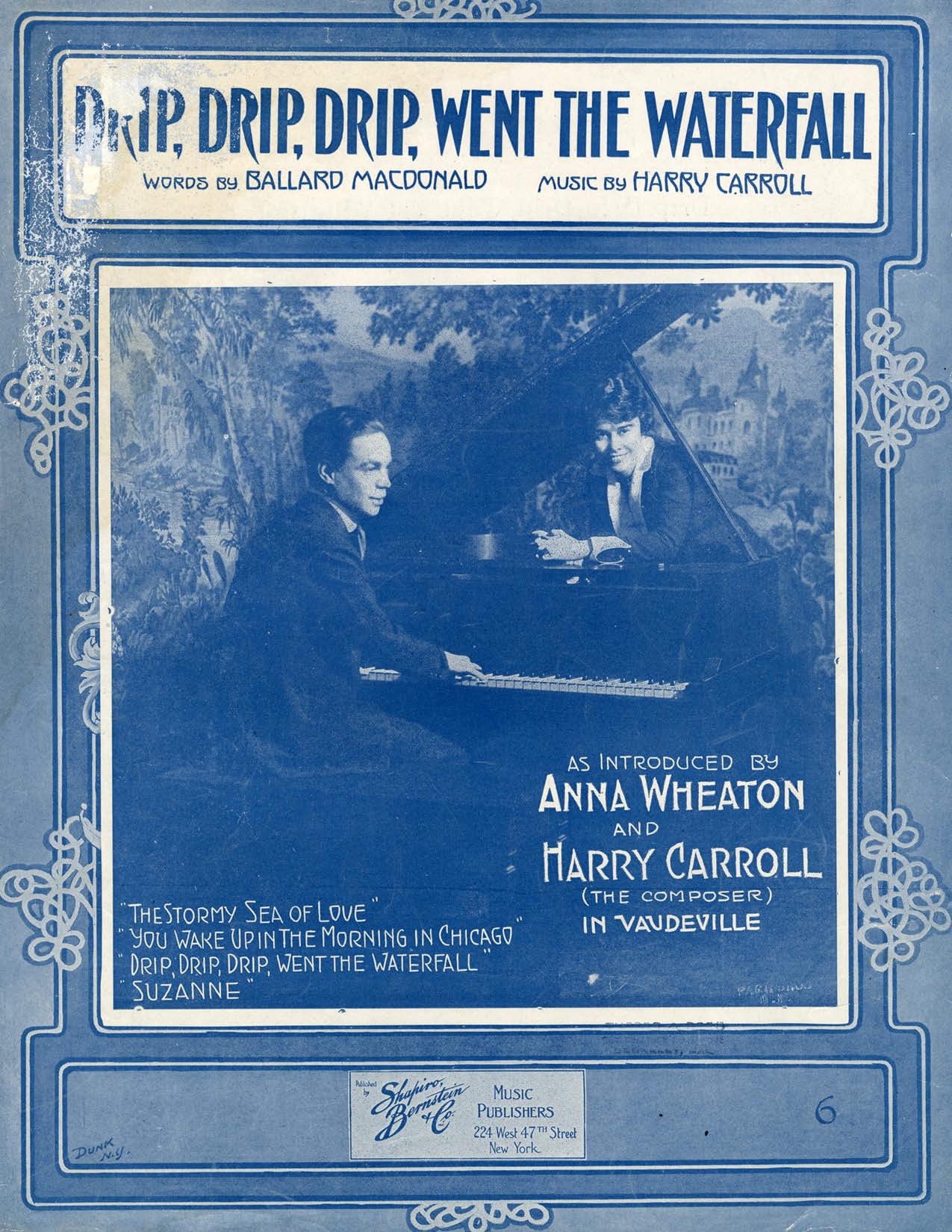
Songwriter Harry Carroll and wife Anna Wheaton
Songs, of which there were reportedly 34 or so depending on which newspaper you read, include "Drip, Drip Went the Waterfall,” "Irish Heart,” "I'll Cling to You," “On the Lake Shore Limited,” ”The Automat Cabaret,” “I’ll be True to the Red, White and Blue,” “That’s the Why We’re in the Play,” and “My Lady of the Lake.”
Songwriter Hall of Fame member Harry Carroll wrote the music and would marry cast member Anna Wheaton, the two of them going in to vaudeville eventually. With all the songs in the show I expected to find more sheet music.
While the show is set in New York and Chicago it had a definite Chicago flavor: Frances plays “Mrs. Lincoln Boulevard.” Others, besides her and Dave Lewis, are Mercedes Lorenze, Anna Wheaton, Eddie Coe (in black-face per the review in the Buffalo Courier), Harry Coote, Luella Gear, Muriel Window, and Robert Keane. (Footnote: Buffalo Enquirer review, op.cit. )Lucille Todd, Bobby Watson, Mary Spellmeyer, William Reynolds, James T. Duffy, Gilbert Gregory. The vaudeville team of Burt Green and Irene Franklin, husband and wife, joined the cast in Chicago as a headliner having deserted their vaudeville tour.(Footnote: “After the Performance,” Indianapolis Star, December 26, 1915, page 15; Obituary, Burton Green, New York Herald November 18, 1922, page 9. )
While there may be posters for the shows with one or two exceptions the graphics are from sheet music covers found online. There are great resources for finding old sheet music in archives around the country. Perhaps the best place to go initially is The UCLA Sheet Music Consortium which is sort of a nation wide finding aid. Specific other collections that I've drawn from are at:
- UCLA's own collection,the Archive of Popular American Music.
- The Sheet Music Collection of the University of Illinois at Chicago.
- The Frances G. Spencer Collection at Baylor University.
- The Arizona State University Sheet Music Collection
- Special thanks to Kathryn at Kent State University archives who scanned and sent me the sheet music for "MayDee" from the Borowitz Sheet Music Collection.
Photo credits not including those from newspaper captures:
- The poster for "Mam'Selle Napoleon" is from WikiMedia Commons. Sheet music cover from Baylor University which has nine complete scores for this show.
- The poster for "Forbidden Land" is from the digital library of the Public Library of Cincinnati and Hamilton County. The other poster is a screen capture of the poster which is for sale at Original Vintage Movie Posters. Cover is from the UCLA Archive of Popular Music. The complete score for the show is at The Sibley Music Library at the Eastman School of Music at the University of Rochester.(New York.)
- "MayDee" cover is from the aforementioned Kent State Library archives. The three pages of the program for "The Jolly Baron" is from the Chicago Public Library online digital collection. The full program, mostly ads, is there.
- "His Highness the Bey" sheet music cover is from the University of Illinois at Chicago, which has the full score of "Julie Dooley."
- "The Isle of Bong Bong" is also from UIC at Chicago collection which has the score to "If I Were the Man in the Moon" song from the show.
- The "Yankee Regent" cover is from Baylor Frances G. Spencer Collection of Popular Sheet Music, full score to song “You’ll Find ‘Em in Chicago.”
- "Umpire" also from Baylor's complete score of "The Umpire is a Most Unhappy Man.
- As well "A Knight for a Day" is Baylore's score of "The Girl in the Great Divide."
- The cover to "Boo hoo! Tee hee!" which Frances sang is also from the Baylor score. Baylor has several other full scores from that show. Arizona State University has six scores from the show.
- Cover to "The Tenderfoot" is from Arizona State University's full score.
- A number of scores from the "Belle of Brittany" can be found at the UCLA Consortium as well as the covers.
- "Jumping Jupiter" is from Wikimedia Commons. The program is from The Chicago Public Library online Digital Collections.
- The cover to "March" from "The Chocolate Soldier" is from UCLA's Archive of Popular Music.
- "Red Petticoat" Boston performance herald is from a sales site, WorthPoint.com: https://www.worthpoint.com/worthopedia/1912-jerome-kern-red-petticoat-musical-comedy
- The cover is from Baylor. I've lost track of where I got the photo of Joe Howard and Mabel McCane.
- "September Morn" is from WikiMedia Commons. The other cover is from the Johns Hopkins Lester S. Levy Sheet Music Collection which has the score online.
- "The Elopers" cover is the UCLA's Archive of Popular American Music.
- The cover to "My Lady of the Lake" in "Within the Loop" is from Baylor's Frances G. Spencer Collection. "Drip, Drip..." is from the Mississippi State University's Digital Collection.
Footnotes:
Page created January-February, 2019 - links checked 10/31/2022
© Text copyright: Steve Spicer
Feel free to contact me about this page.
